Since his last visit here to explain the work of RISE on The Dark Tower, Florian Gellinger has taken care of many shows at RISE as Executive VFX Producer such as Avengers: Infinity War, Westworld, WandaVision and Loki.
How did you and RISE get involved on this show?
We received a lot of praise for our seamless environments for Doctor Sleep at Warner Bros. We also had a pre-existing working relationship with Lisa Joy, the director of Reminiscence, and the wonderful people at her production company Kilter Films for the 3rd Season of Westworld. We were very happy to hear that we’d also be the preferred partner for this show.
How was this new collaboration with Director Lisa Joy?
Lisa is a visionary writer, show runner and director. The most memorable trait of Lisa was definitely how good her knowledge of design, architecture and style in general is. The script for Reminiscence was an amazing read and the world she had created was a good challenge to visualize. What added to the challenge was that the movie wrapped shooting in February 2020, just when Covid hit and everyone started working from home. The production team was going into post-production working remotely, just like almost our entire team. They had to re-organize, just like we did. Our IT and pipeline departments did an outstanding job in getting everyone across 4 facilities ready to work remotely, just days after our clients approved the move, all while ramping up remotely with our new team in London.
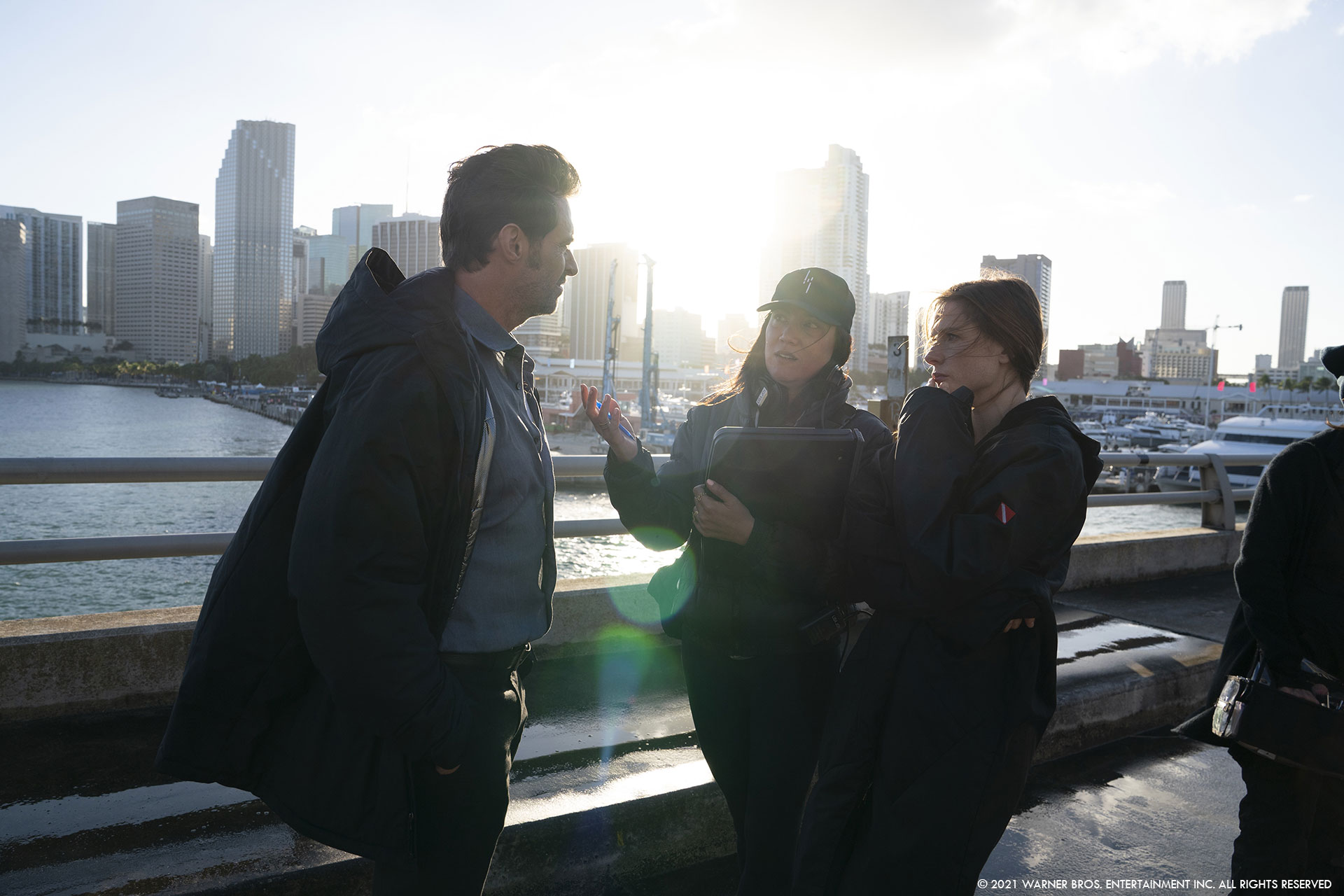
Can you tell us more about your work with Overall VFX Supervisor Bruce Jones?
Bruce is an absolute sweetheart and the work he had done to clarify the geography of the story helped us tremendously. He has a long history of working in VFX and banks on a wealth of experience. This was particularly helpful when he dug up references to communicate the desired approach more clearly. With the limited amount of socializing we all had in 2020, our CineSyncs and calls were always something to look forward to. You could tell that the production team was having a good time, just like we did, against all odds.
What were their expectations and approach about the visual effects?
We started off with a bunch of relatively straight forward set-extensions and some clashing wave simulations, seamless, non-attention-gabbing work as usually required for a drama. Then, as time progressed and the edit was assembled, it became apparent that the world the story is set in, needs additional exposition. During the shoot, some drone plates were shot of various backgrounds and locations, but not enough to show what Lisa had in mind. After discussing our options with Bruce we heard back from the studio that we would not get permission to shoot any additional plates or do LiDAR scanning on location during lockdown. We realized that we would need to create a lot of the visuals from scratch without source material.
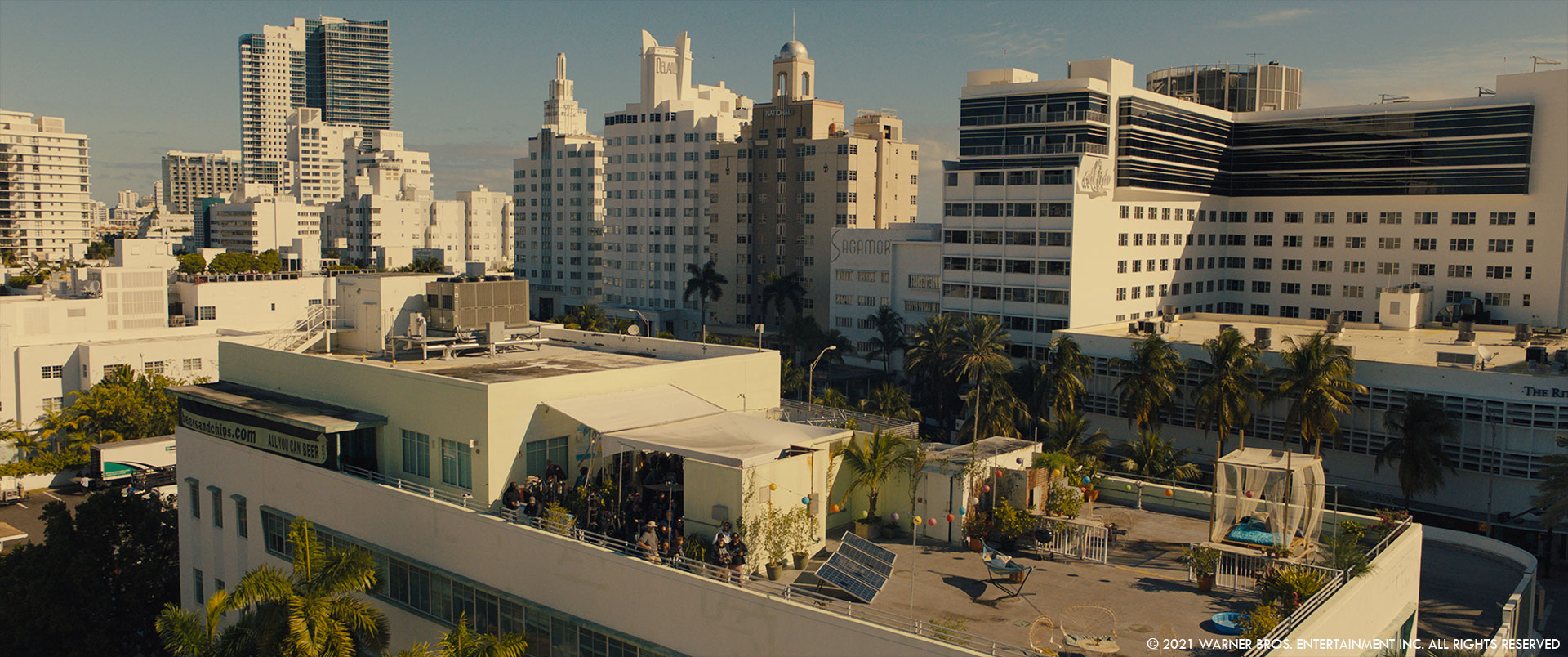
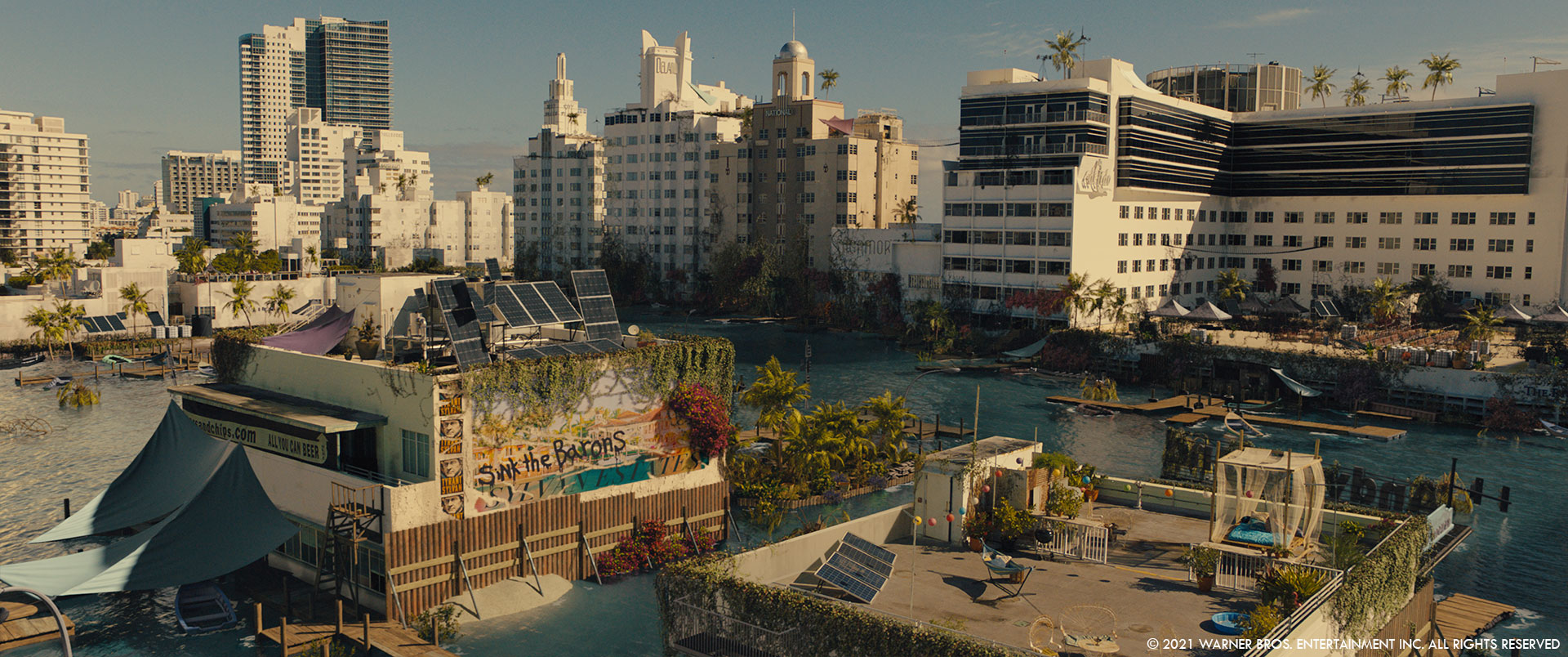
How did you organize the work with your VFX Producer?
We get along very well since we also live and share all of our day together – I took on both roles myself because it seemed like a small but very interesting show. When that changed, I started to hand over more and more paperwork to our superstar production manager Anne Barger.
How did you split the work amongst the RISE offices?
RISE Stuttgart was in charge of some asset builds and a lot of lighting and compositing, especially for the rooftop and underwater fights plus the eel tank. Stuttgart also did comp on some large establishing shots. RISE Berlin with Matthias Winkler as CG supervisor, Oliver Hohn as compositing supervisor and Andreas Giesen as FX supervisor as well as Niklas Roth leading build and scene layout tried to sort the workload and put together the biggest full CG establishers.
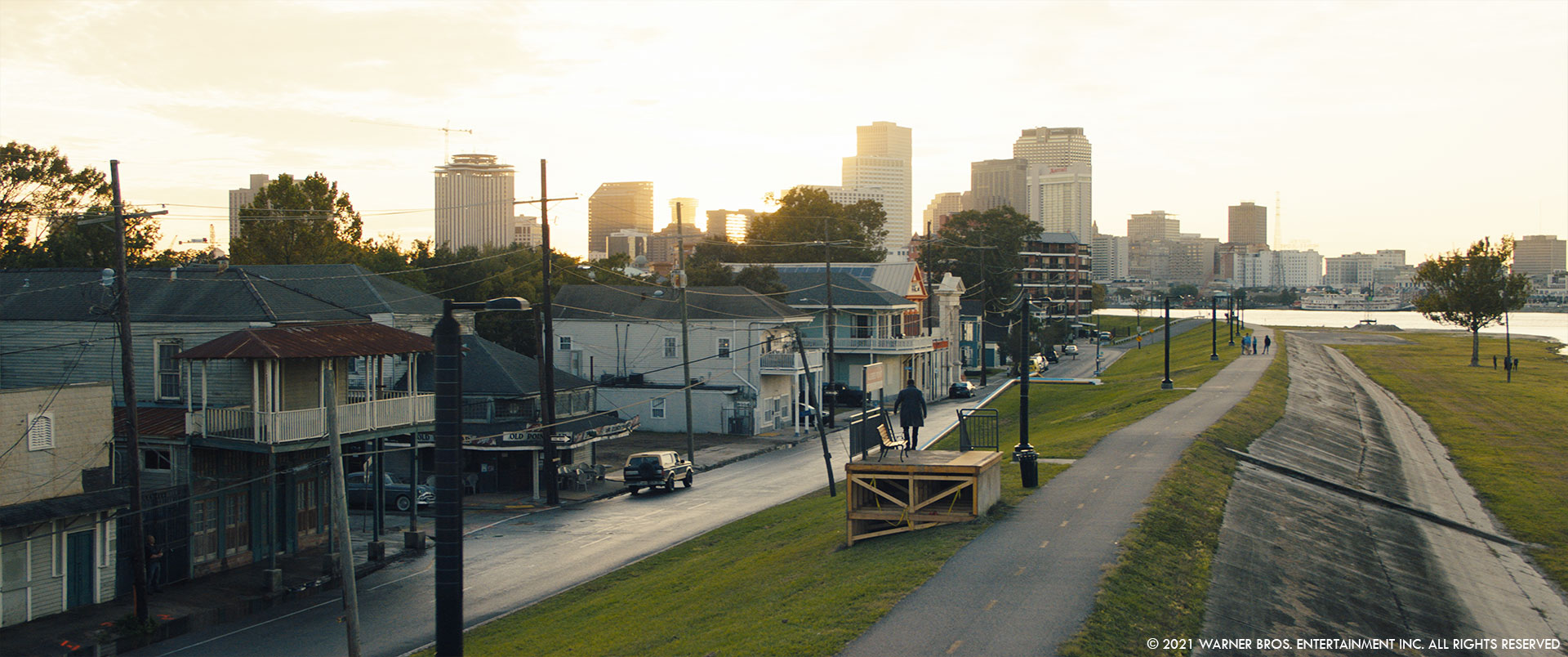
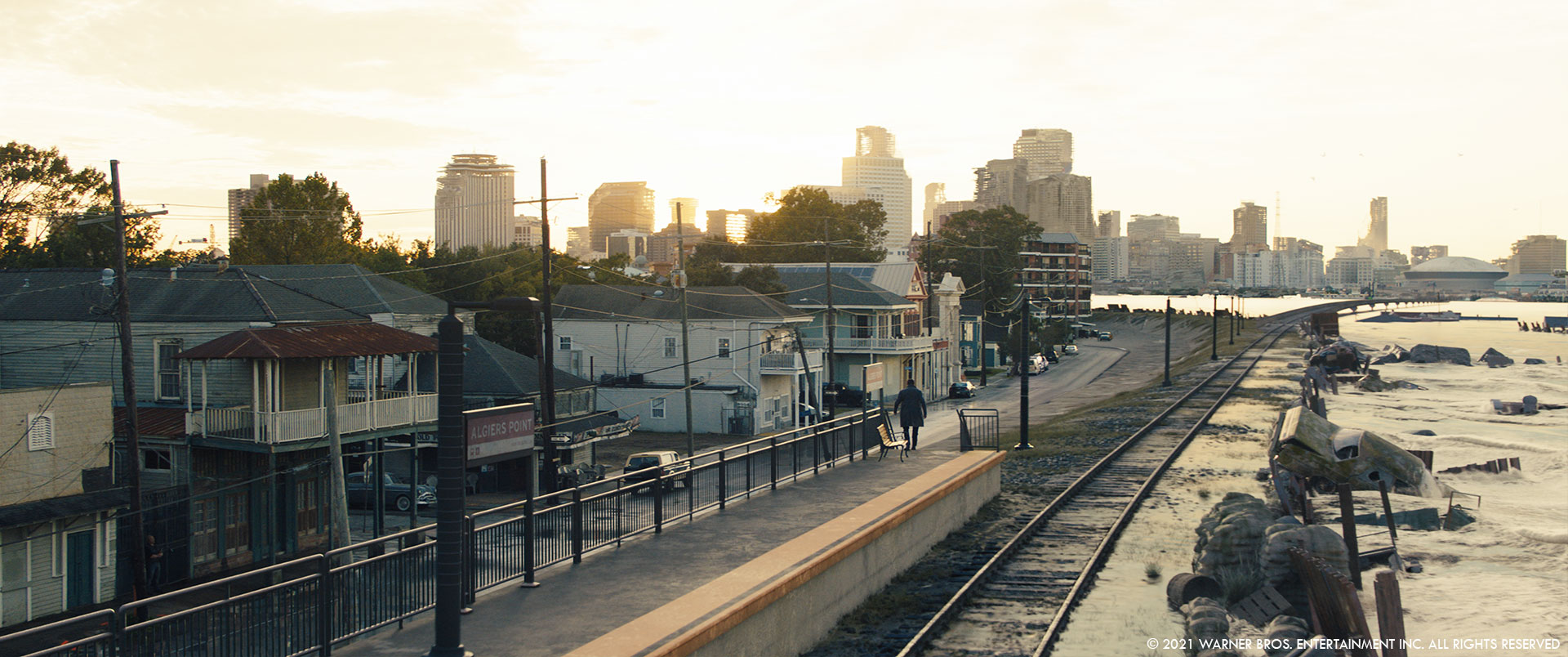
What are the sequences made by RISE?
We created the 2min 40sec opening shot, a ton of individual day and night one-of establishers of Miami with raised water levels, the train journey to New Orleans, the shoot-out at St. James place including the CG eel tank, the floating market, the recycling plant, the rooftop fight, the underwater fight, the Miami riots and breaking dam as well as all shots of the freedom tower.
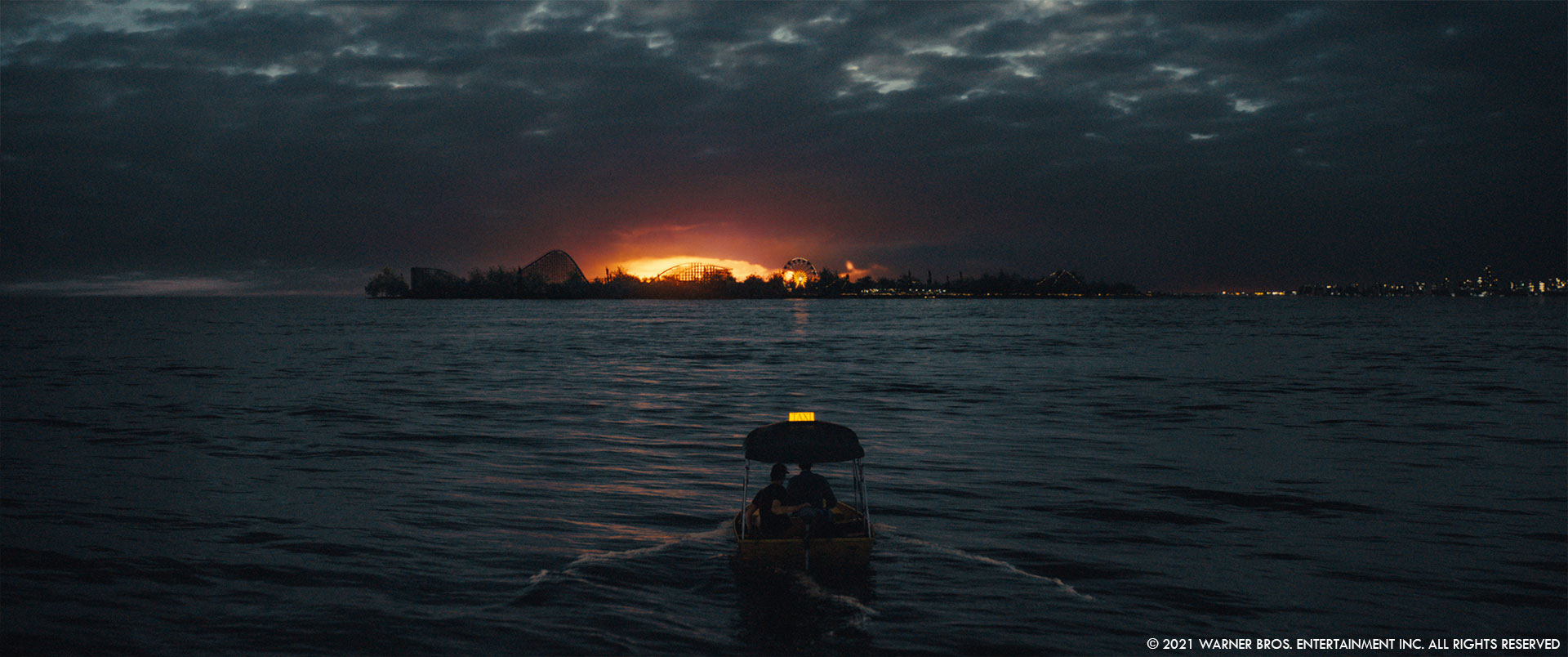
In the movie, Miami is massively submerged by water. What was your approach about it?
The plan was to create proxy geometry for everything we see in the plate, re-project the plate onto the proxy geometry and drop in a CG ocean with interactive FLIP sims when interacting with buildings. This plan only worked for roughly 50 percent of all shots since we started moving buildings, adding buildings and art directing every inch of the city scape.
Did you received specific indications and references for the city?
There were a couple of really good concepts done by the production art department, especially for the dam in Miami and the underwater fight. For the city, since we had to model every building anyway, we started rearranging the cityscape once we had the plates aligned resulting in more flexibility in scene layout. That workflow also enabled us to present moving shots rather than stills.
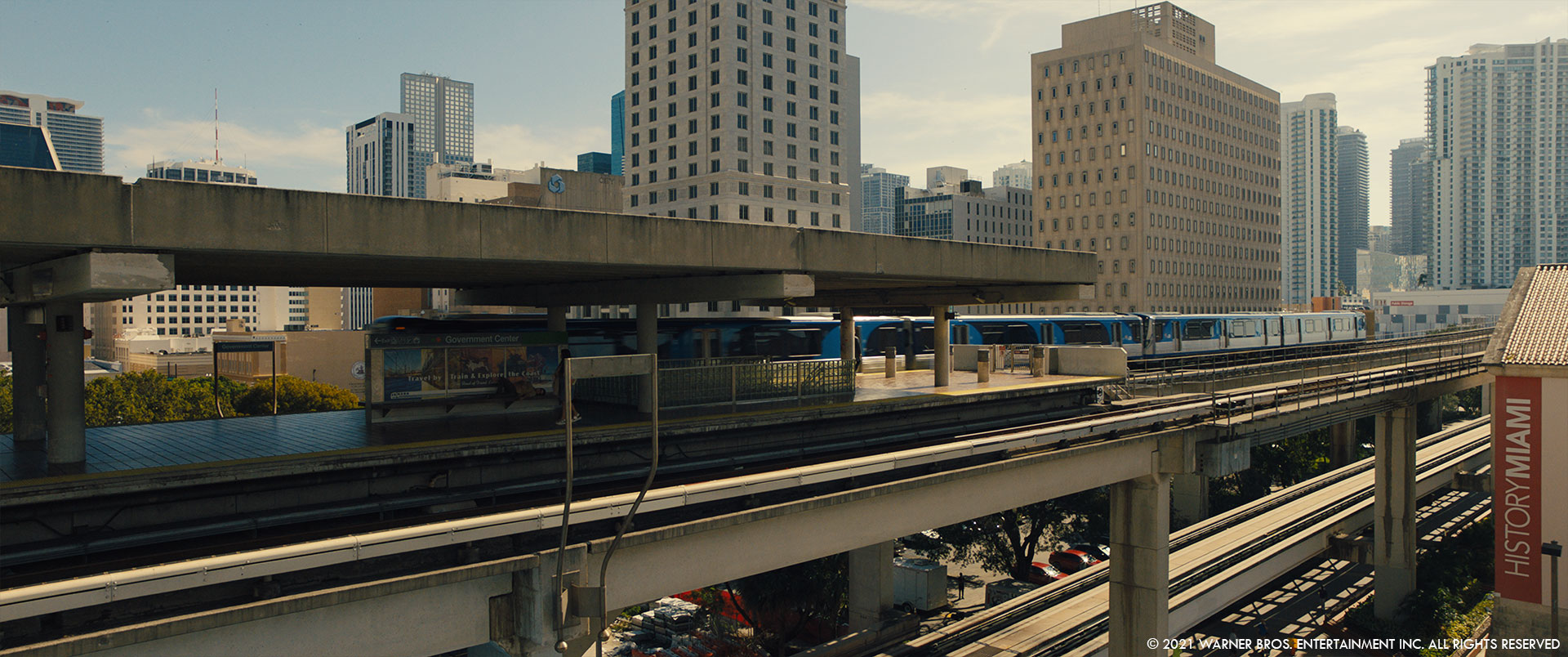
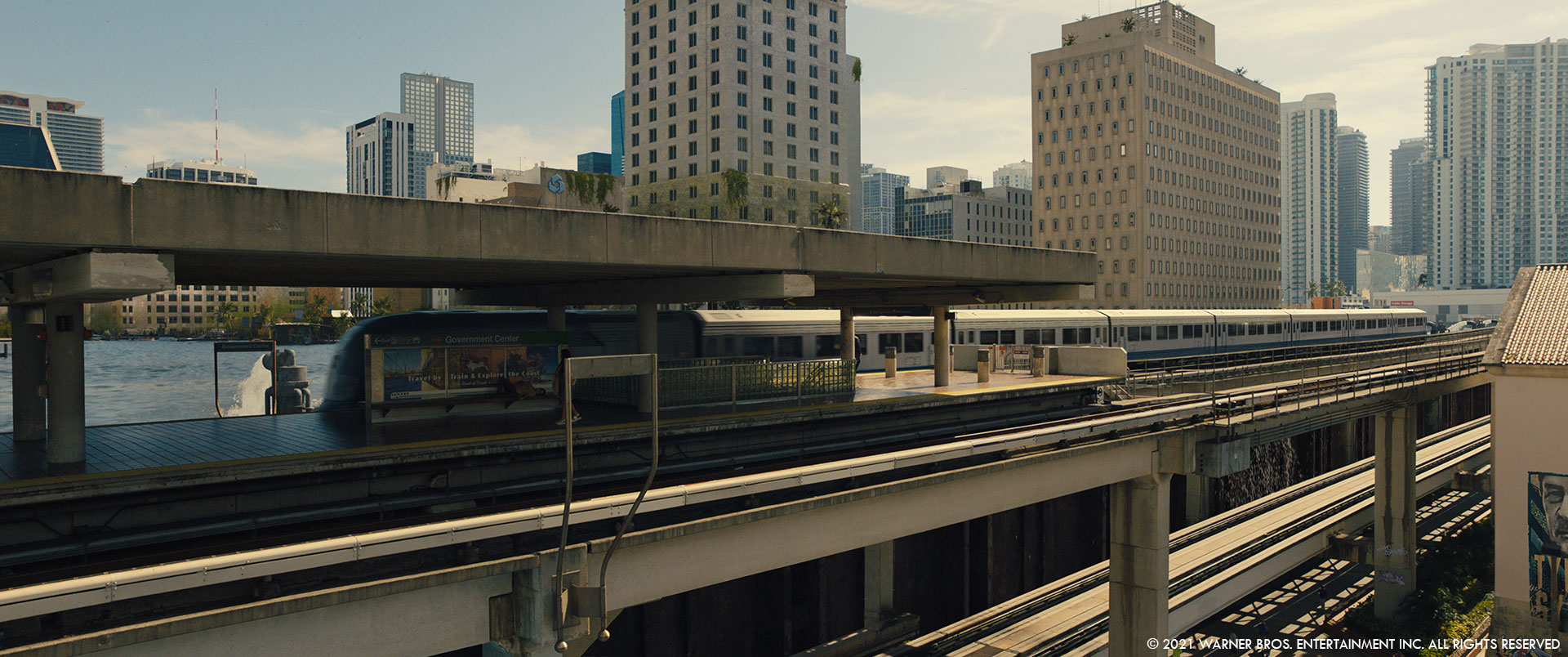
Can you explain in detail about the impressive opening shot?
The opening shot is 2min 16 seconds in length (or 3267 frames) and is one of the most challenging pieces of work RISE has done to date. The shot is supposed to show right at the start of the movie how the world in this not too distant future works. The camera sweeps from sunken Miami beach, flies over a couple of story points for later in the film, over the Miami bay and the floating market amusement island into Brickel and over the dam to find our main protagonist picking up a playing card in the spill water flooding the streets. All the boats, people and trains move in real time, the time of day is in time lapse covering the setting sun and following nightlife from 4pm to 11pm, lights coming on in all of the skyscrapers reflecting nicely in the bay. Due to global warming the city is relatively calm during the day and comes alive after sunset when the temperatures drop. The entire shot is one insanely complex and detailed 3D build, even the road that Hugh Jackman is walking down and the card he is picking up are CG.
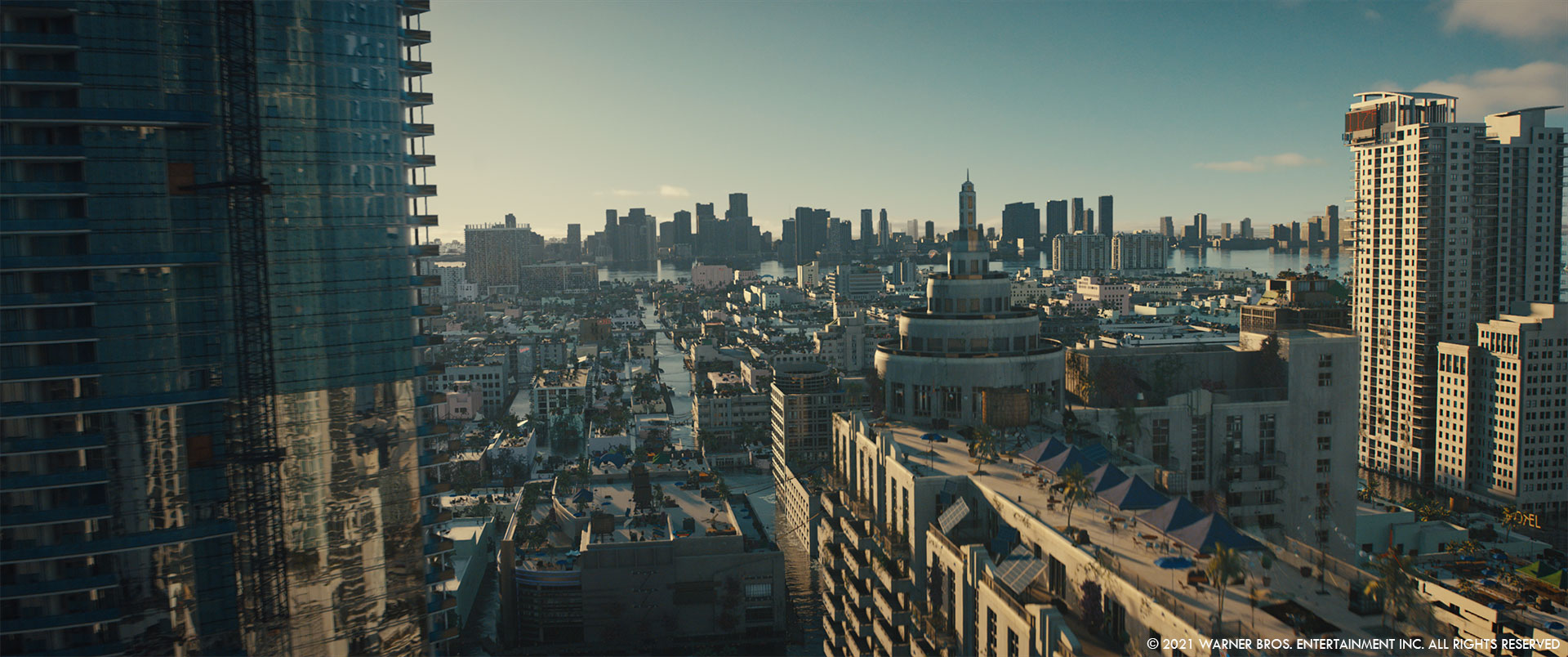
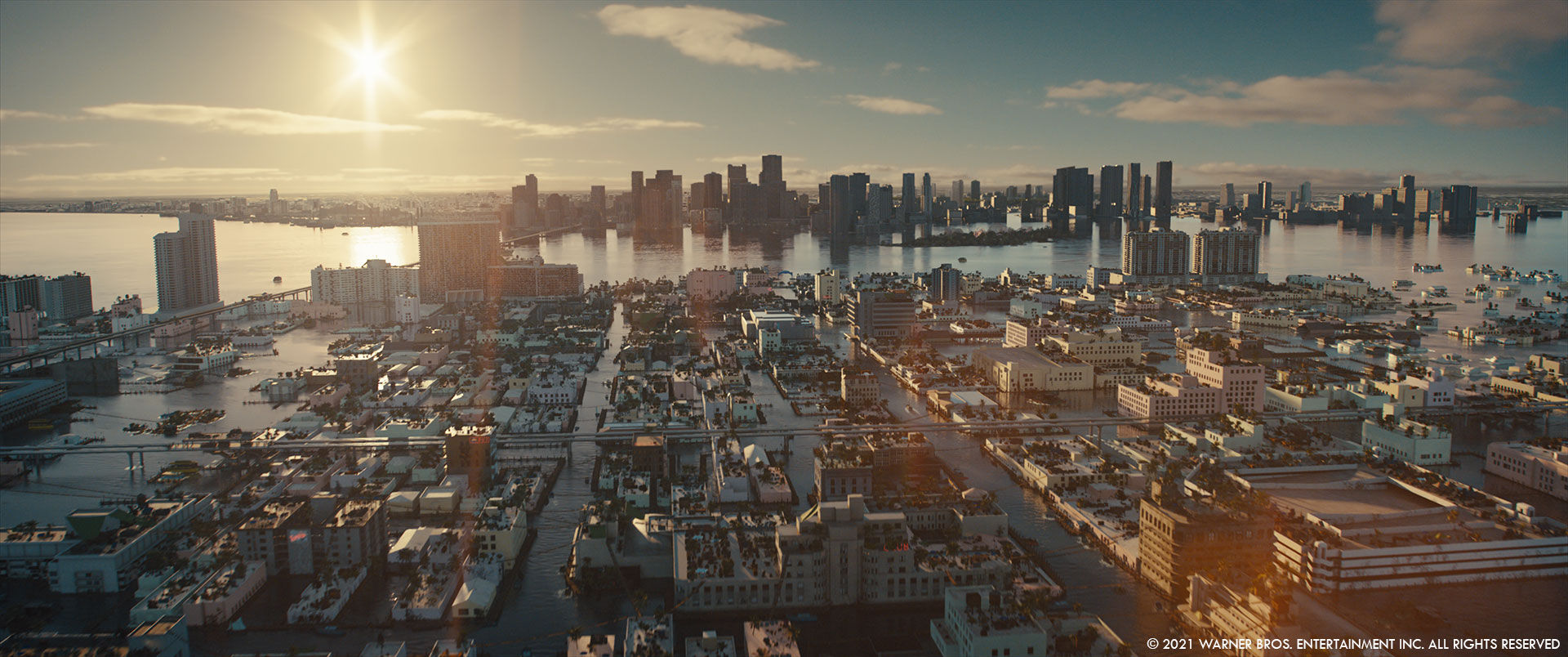
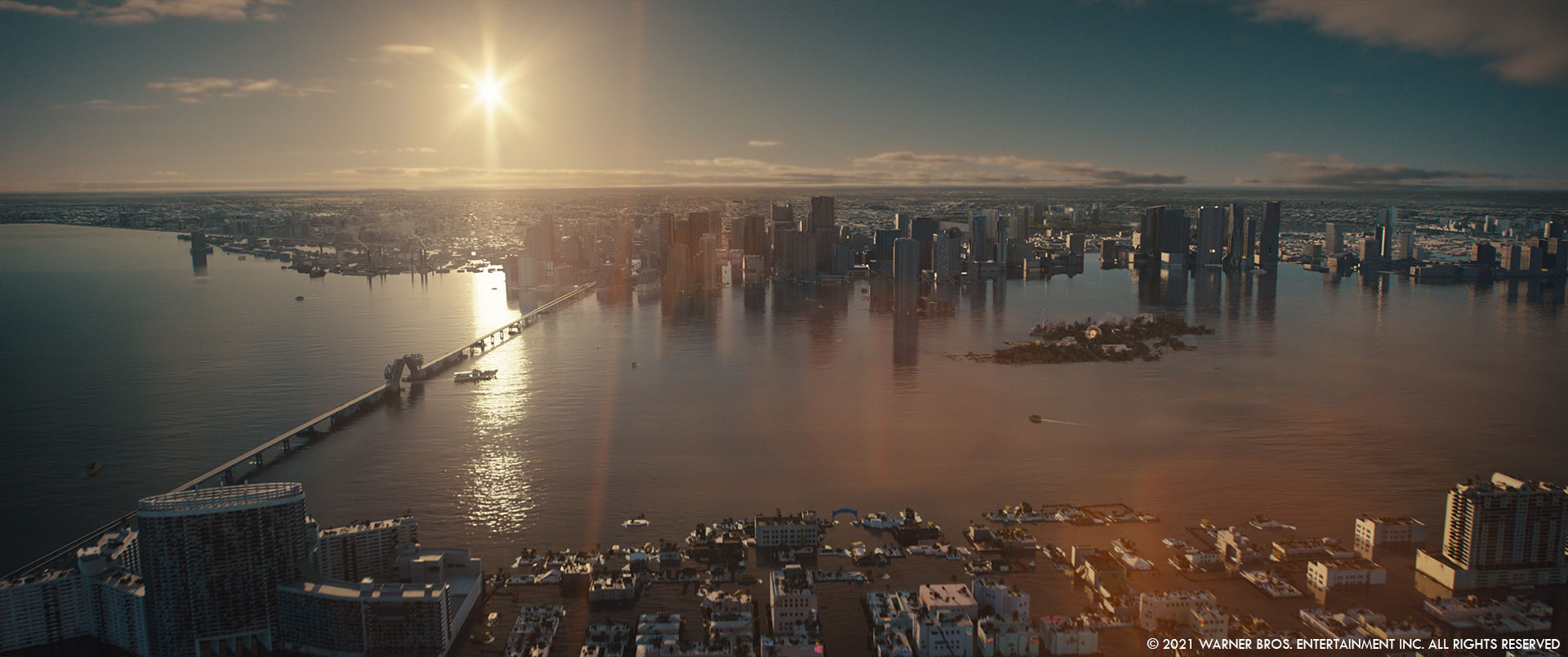
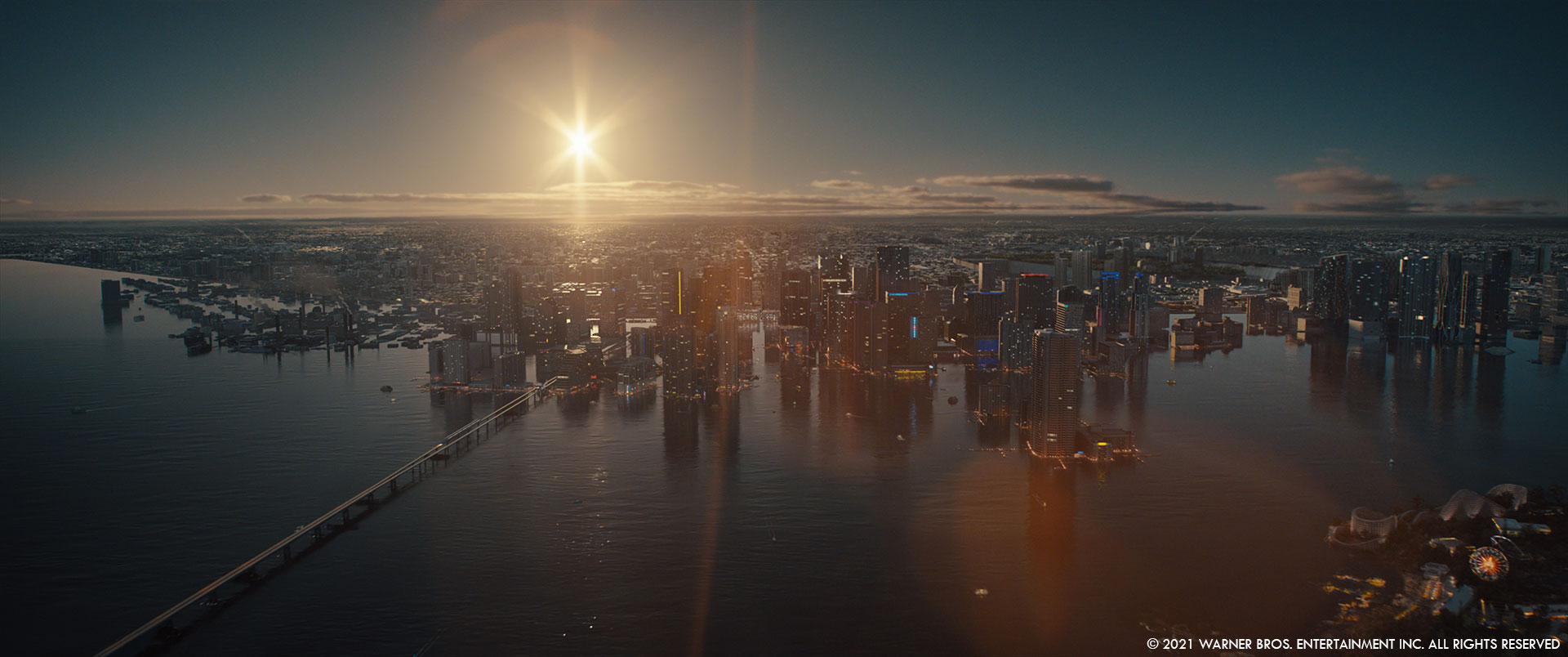
This shot is really long. How did you handle it on the render side?
We didn’t. We only saw the shot a couple of times in motion before we had to deliver. But every iteration had so many updates coming in from so many artists, brilliantly orchestrated by Bernhard Esperester and Niklas Roth combining manual 3D modelling and procedural dressing techniques, that every time we saw the shot we were taking leaps forward. Michael Lankes comped the shot and had tons of IDs and passes at his disposal, not necessarily making it easier keeping the frame count in mind. And with every additional layer the risk of having to re-render or fix increases. So in the end Michael was part librarian, keeping track of all the nuts and bolts, and part artist taking those pieces and turning them into something stunning. Jonathan Weber and Roy Hoes helped in putting the second part of the shot with Hugh Jackman together, re-integrating the extras on cards with water interaction on the flooded street.
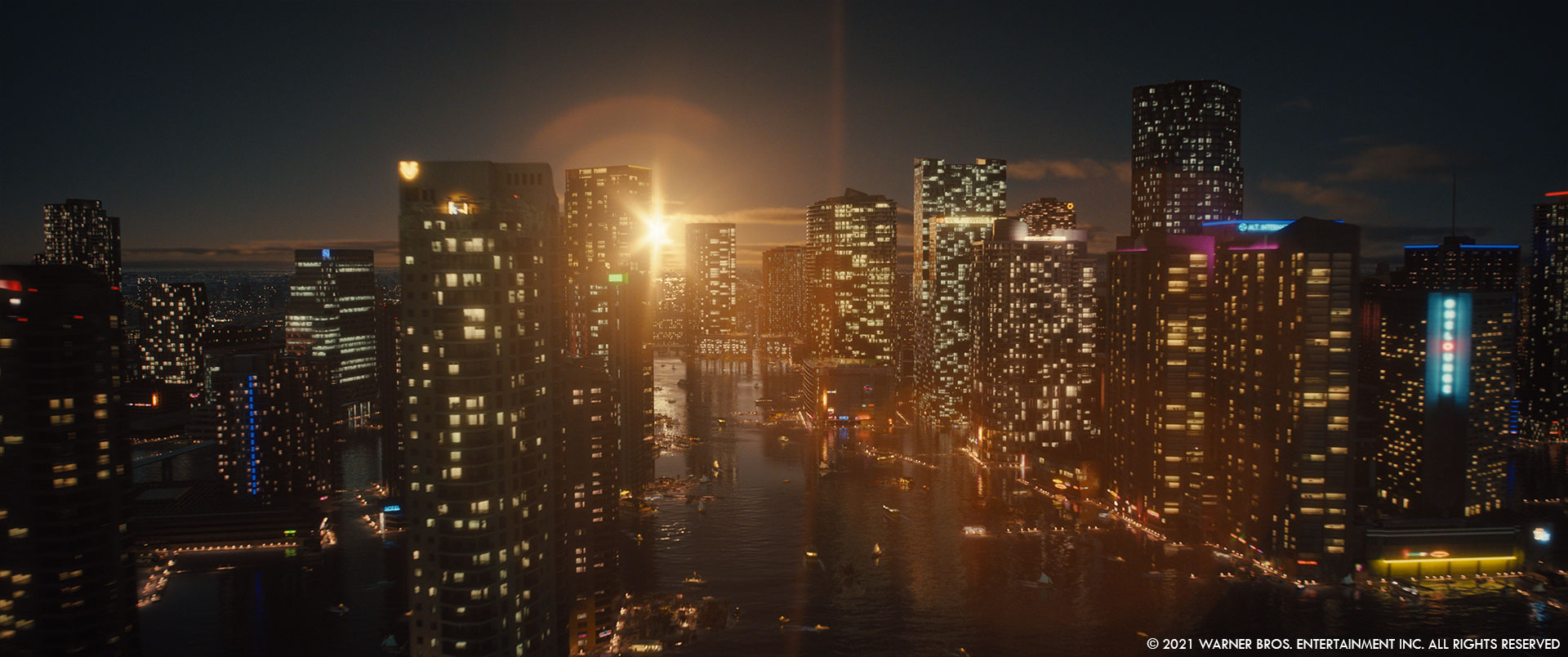
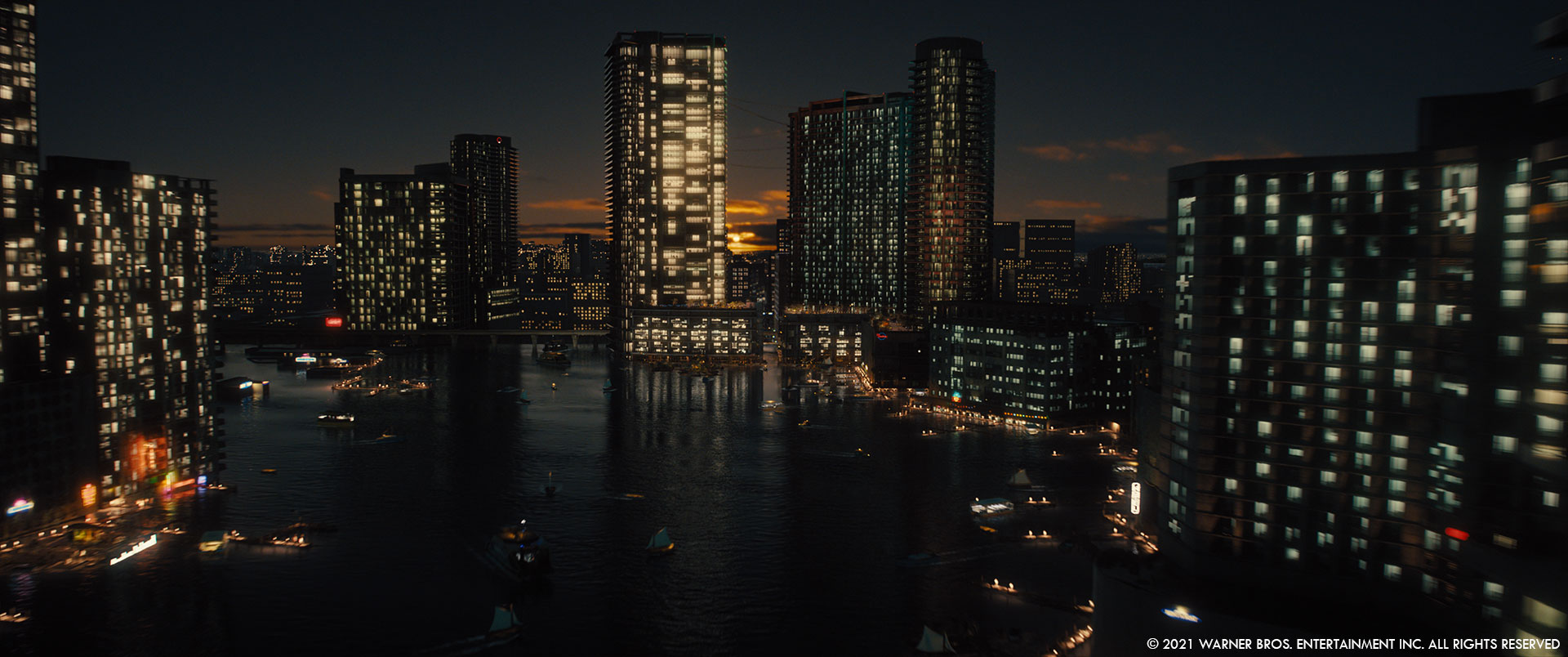
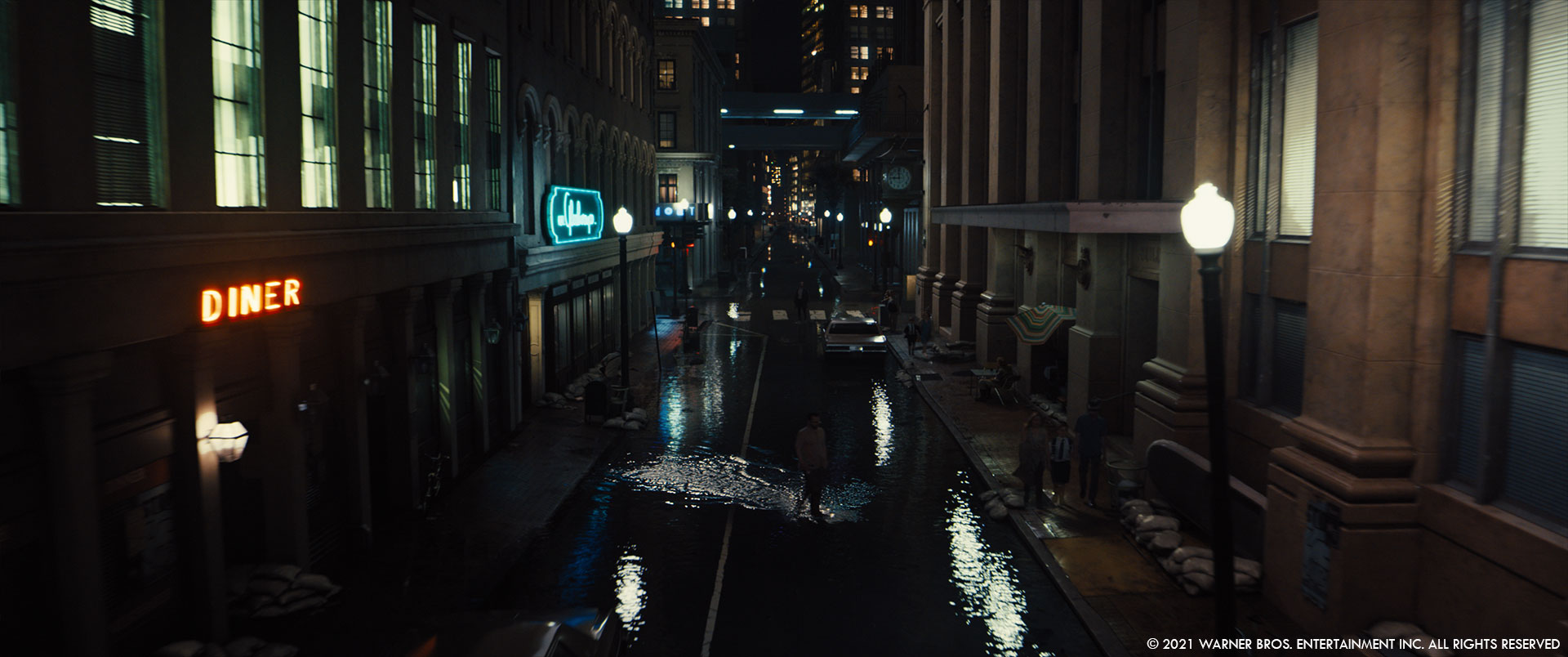
Can you elaborates about the water simulations?
The water simulation caches had to be incredibly long because the interactive ocean is in frame for such a long stretch. Our FX supervisor Andreas Giesen and his team had just finished a German kids movie called Jim Button and the Wild 13 as VFX supervisor for which we built a highly iterative Houdini FLIP fluid simulation pipeline. This was essential for Reminiscence as almost every single one of our shots needed water. On the opening shot we had to decide for a level of detail for the interacting geometry to make sure the water behaves correctly when hitting a fire escape or a balcony. In the end the shot uses many bits and pieces of simulation caches instead of one large simulation to be able to art direct individual areas more easily. For boats to populate the city vistas we used pre-cached boat wakes and trails that were dropped in after blocking, boats interacting with the waves based on their size and weight.
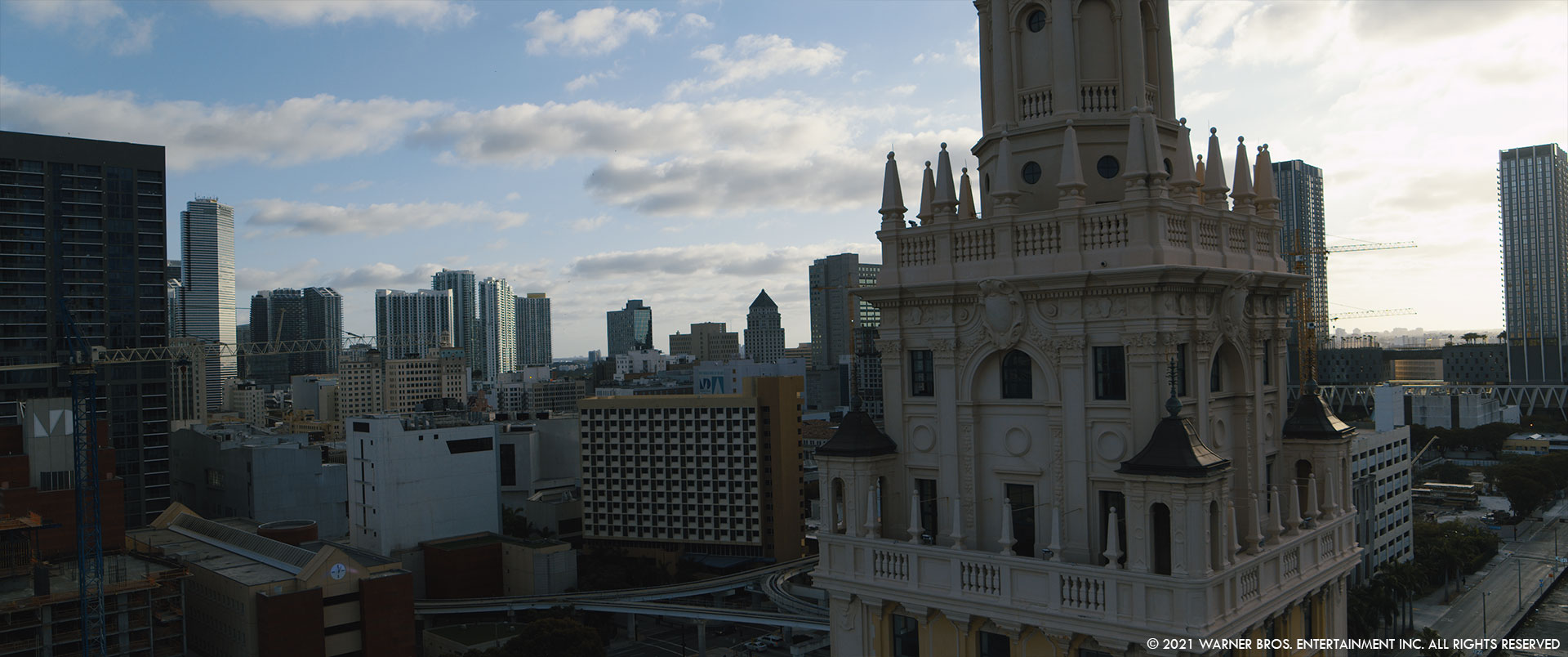
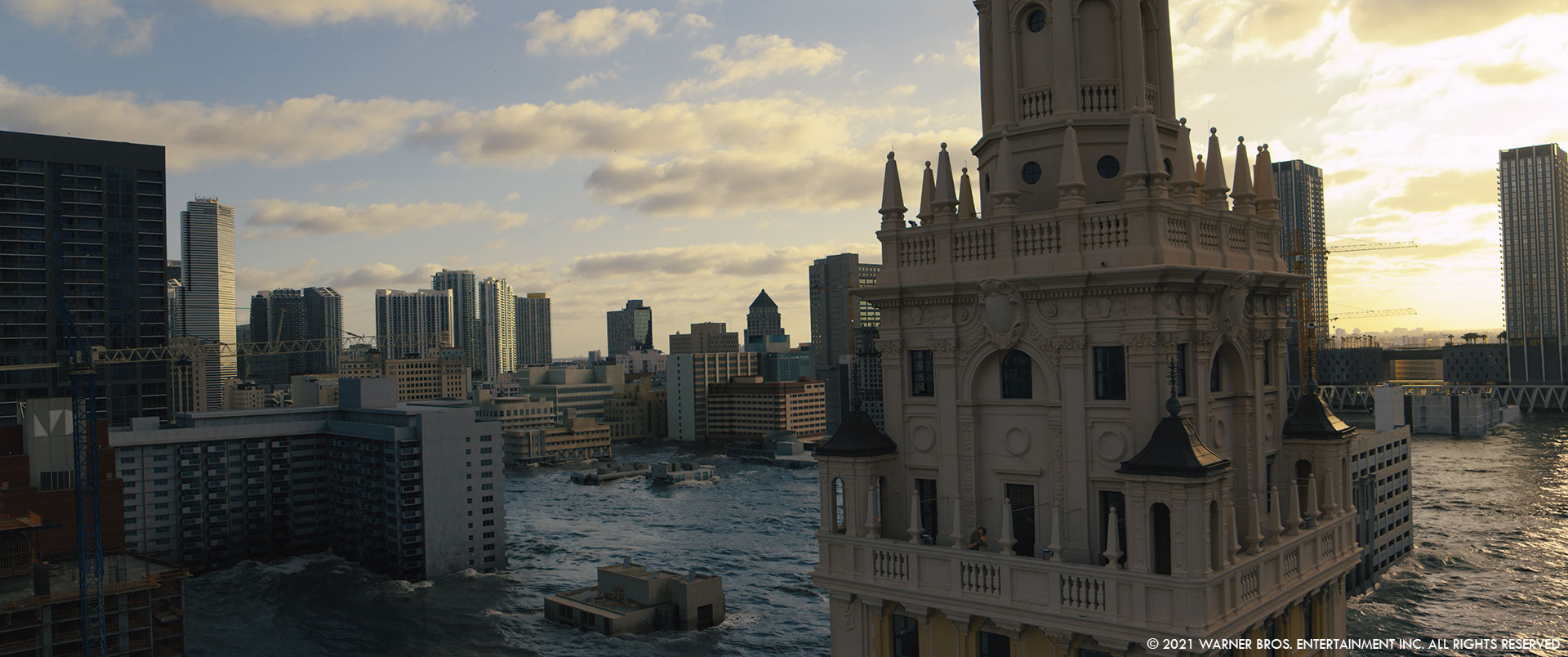
How does the night shots affects your lighting work?
Reflections were key since that’s all that gives away a water surface at night. We didn’t want to go for a magical full moon night so we had to make up the lack of light by adding tons of neon signs and illuminated windows. The neon signs were all traditionally modelled by hand, the rooms are all cubical HDRs that are smartly cropped in dependence of the camera position to give the illusion of parallax. Add a couple of instanced curtains and you have something that looks absolutely believable. You can even see our team dance as silhouettes in one of the night shots, a quick shoot we did in front of a brightly lit white wall in our office.
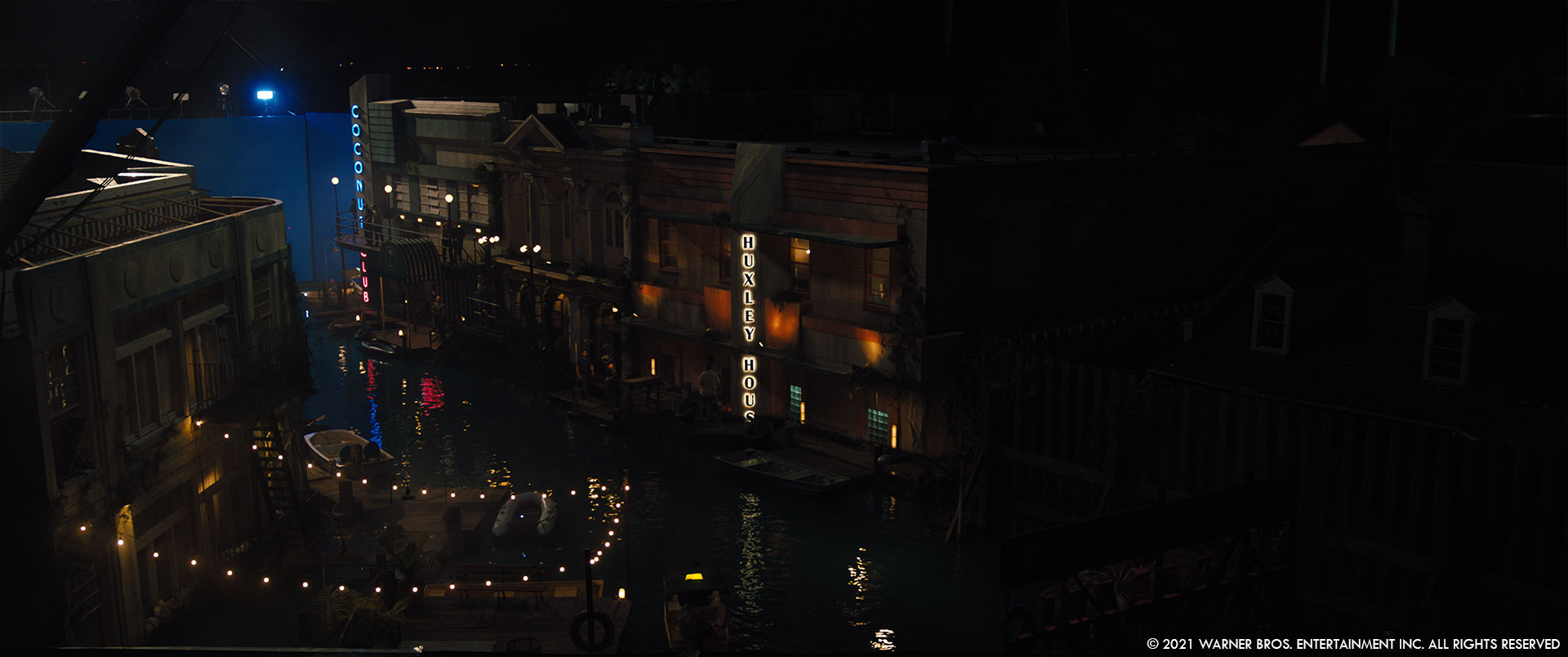
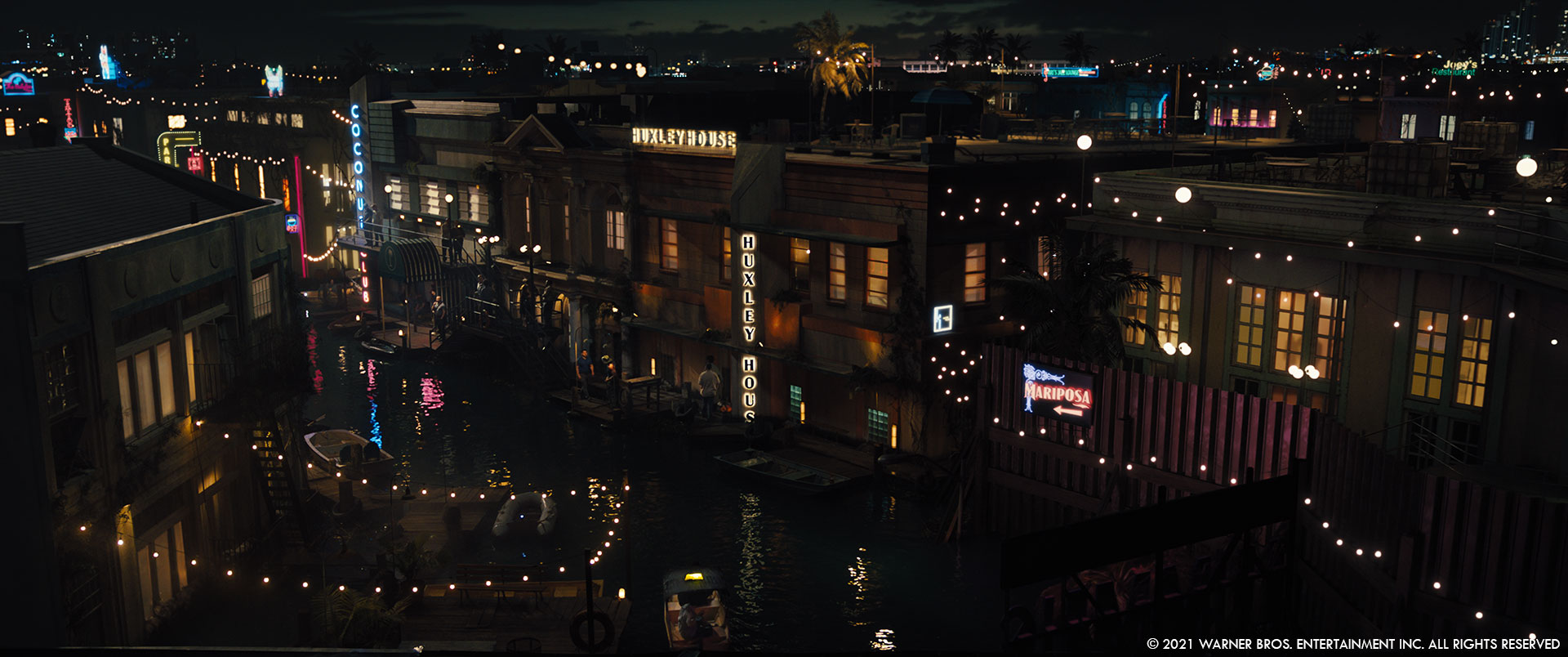
With so many elements and long shots, how did you prevent you render farm to don’t burn?
We didn’t, we used it as our heating instead. Seriously, this show was some crazy progress bar watching.
Did you used procedural tools to create the various locations of the city?
Not really. We always started with a one-of build for blocking and then used procedural tools mostly to populate these builds with ACs, vines, dirt around the water line and foam, rooftop furniture like chairs and tents.
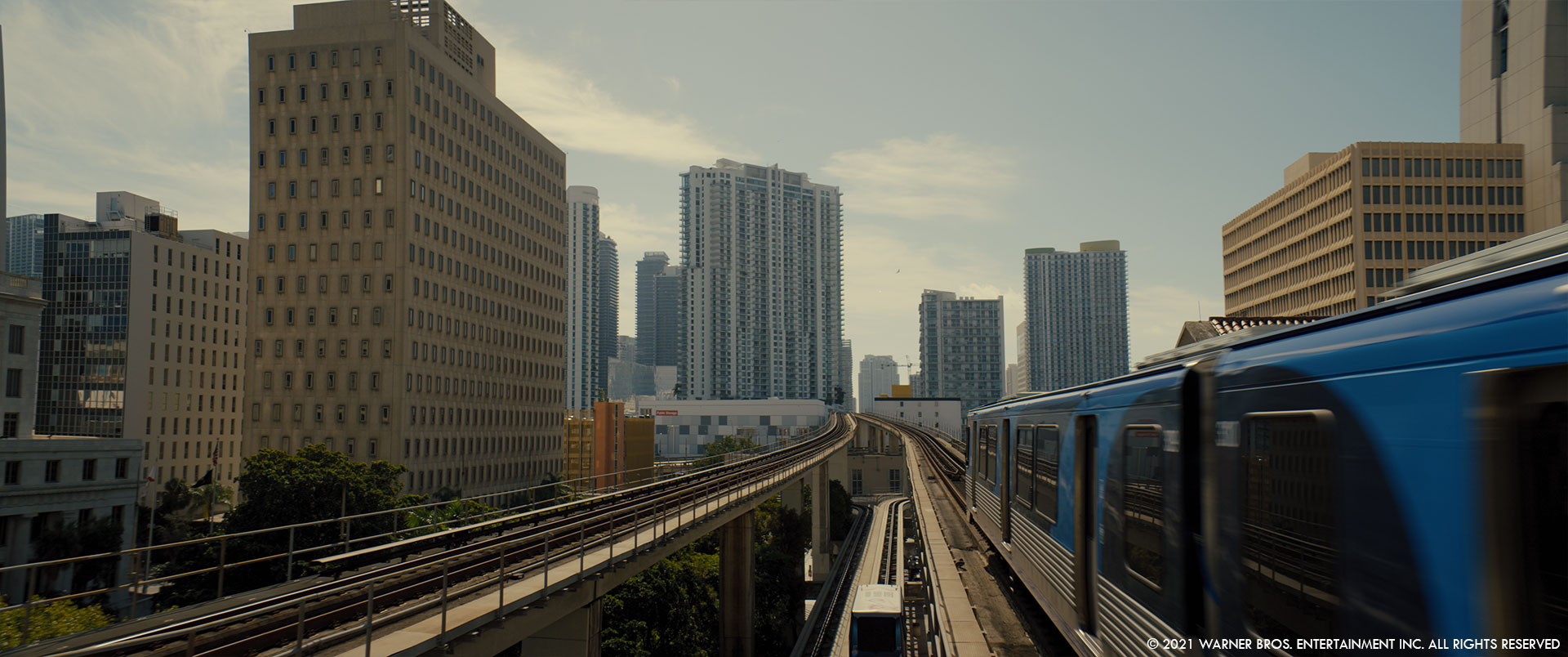
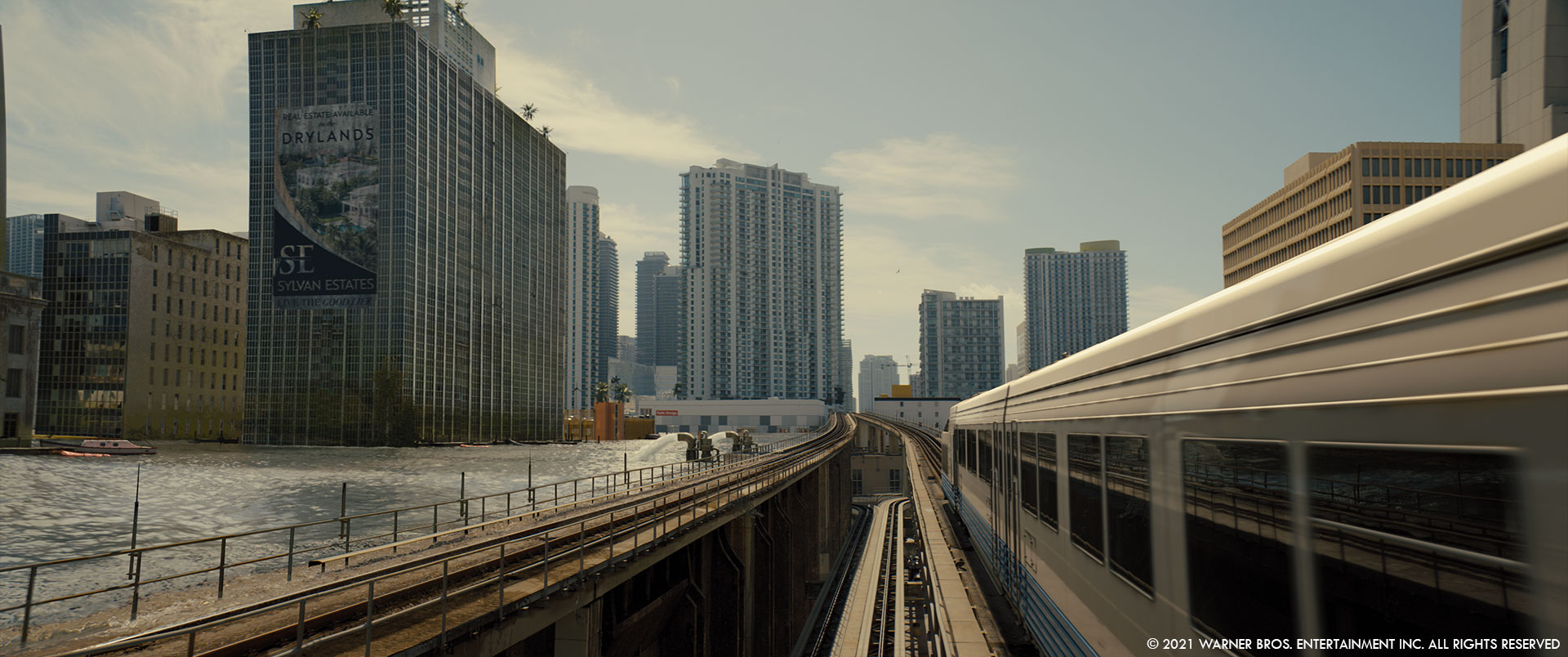
Which place was the most complicated to create and why?
All of it! You see so much of the city in every single shot and making it all work was making the assets work that you see everywhere. Changing the look in one shot implied changing the language in other shots of the same city. But since you see all of the city in the opening shot, this is most definitely the best representation of this place.
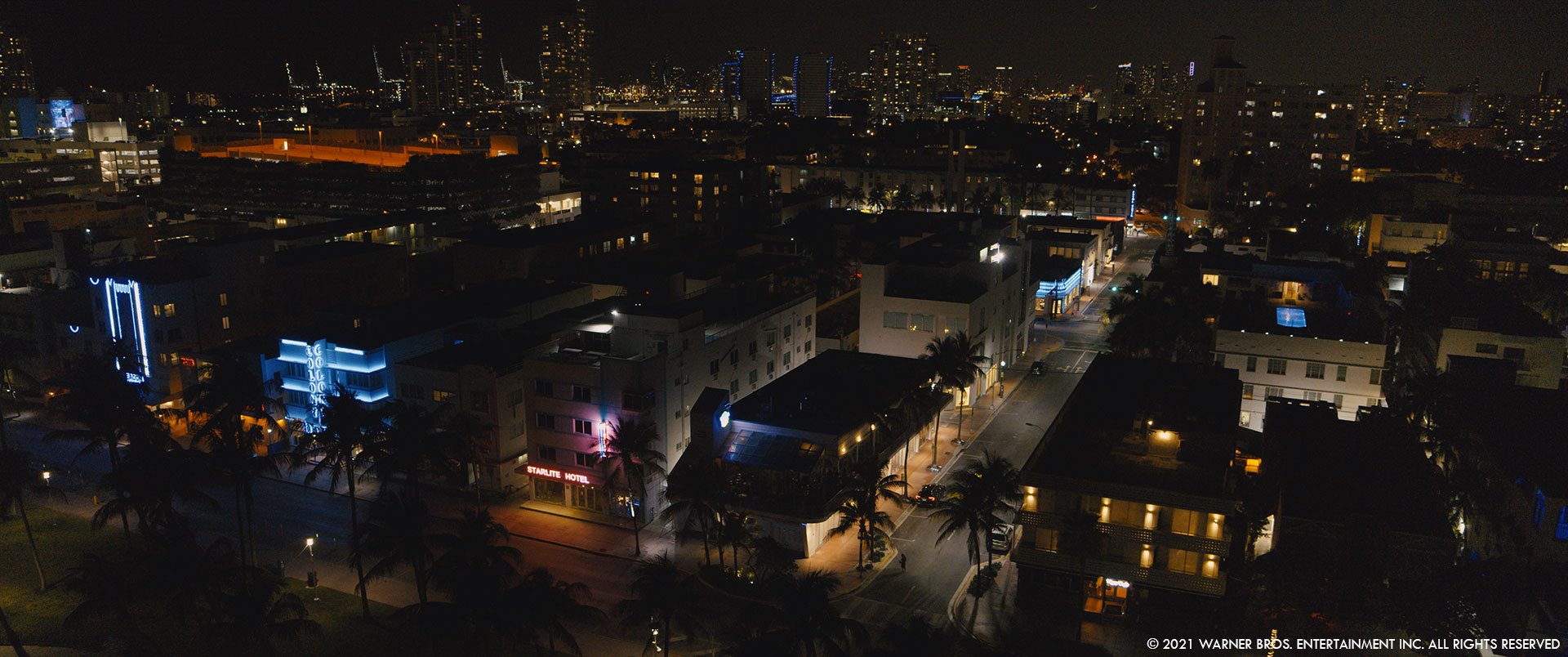
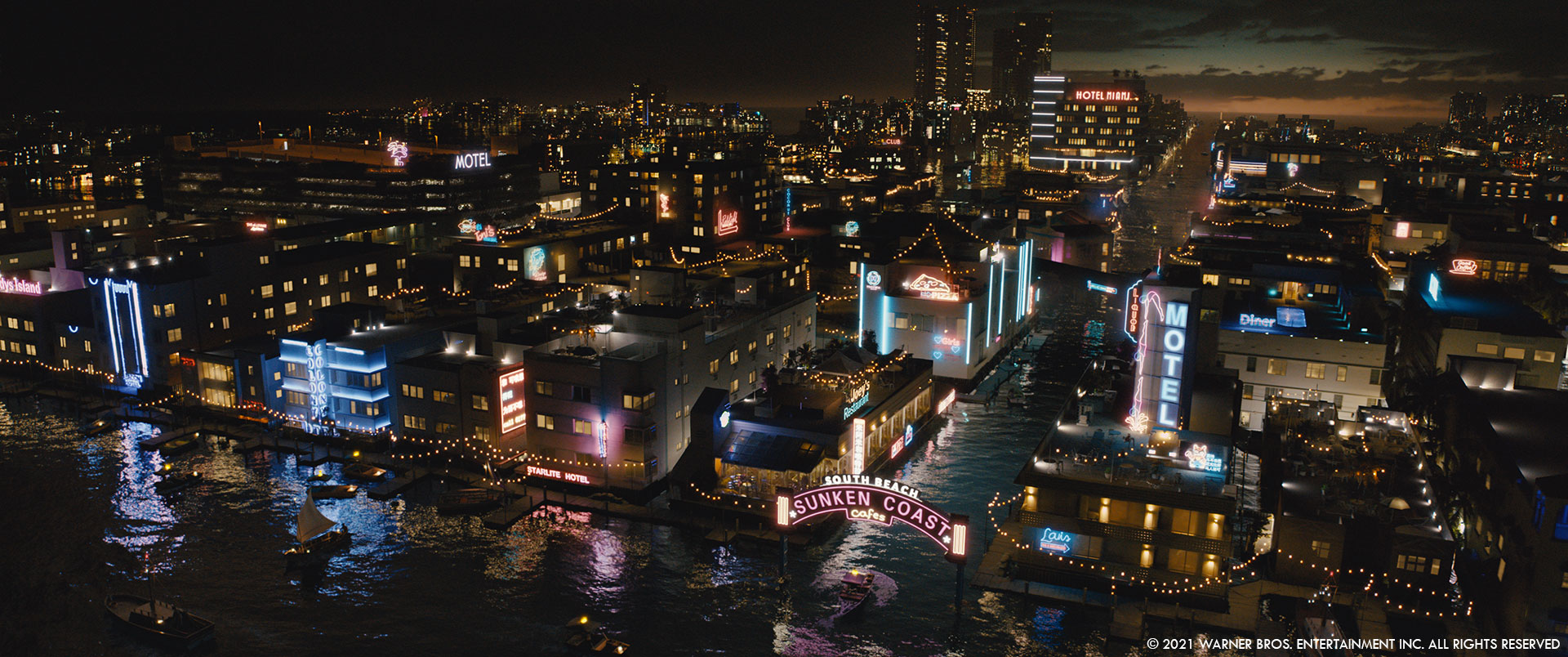
Can you explain in detail about the train creation?
Because the world in Reminiscence is not the distant future, every bit of design needed to feel original but grounded in Today’s time. We started with an encapsulated steam train that the director liked and modified the silhouette, color and tech with pieces from the French bullet train TGV. That way we ended up having something very unusual but something the audience could relate to. The train cars were based on the set used for the shots of Hugh Jackman sitting inside and looking out of the window. We built the interior first and then adapted an exterior that would work well with the engine.
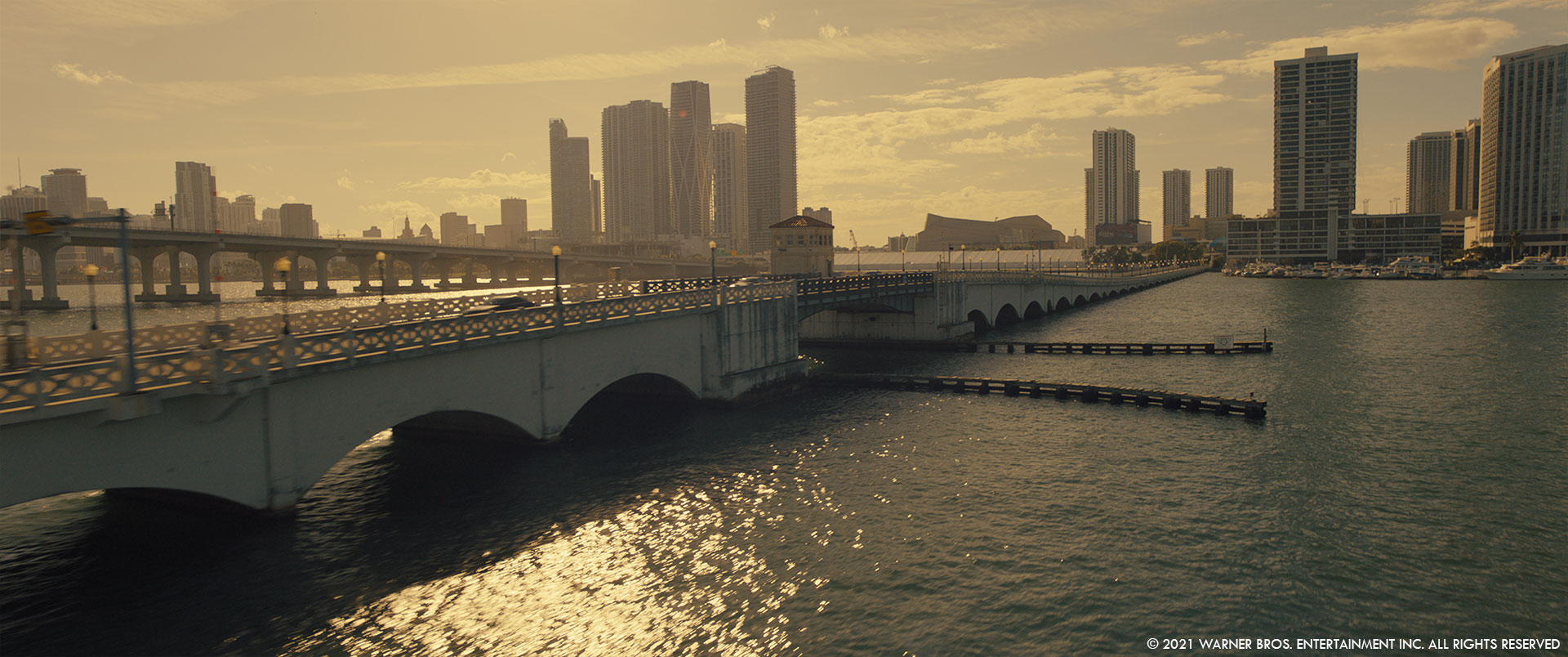
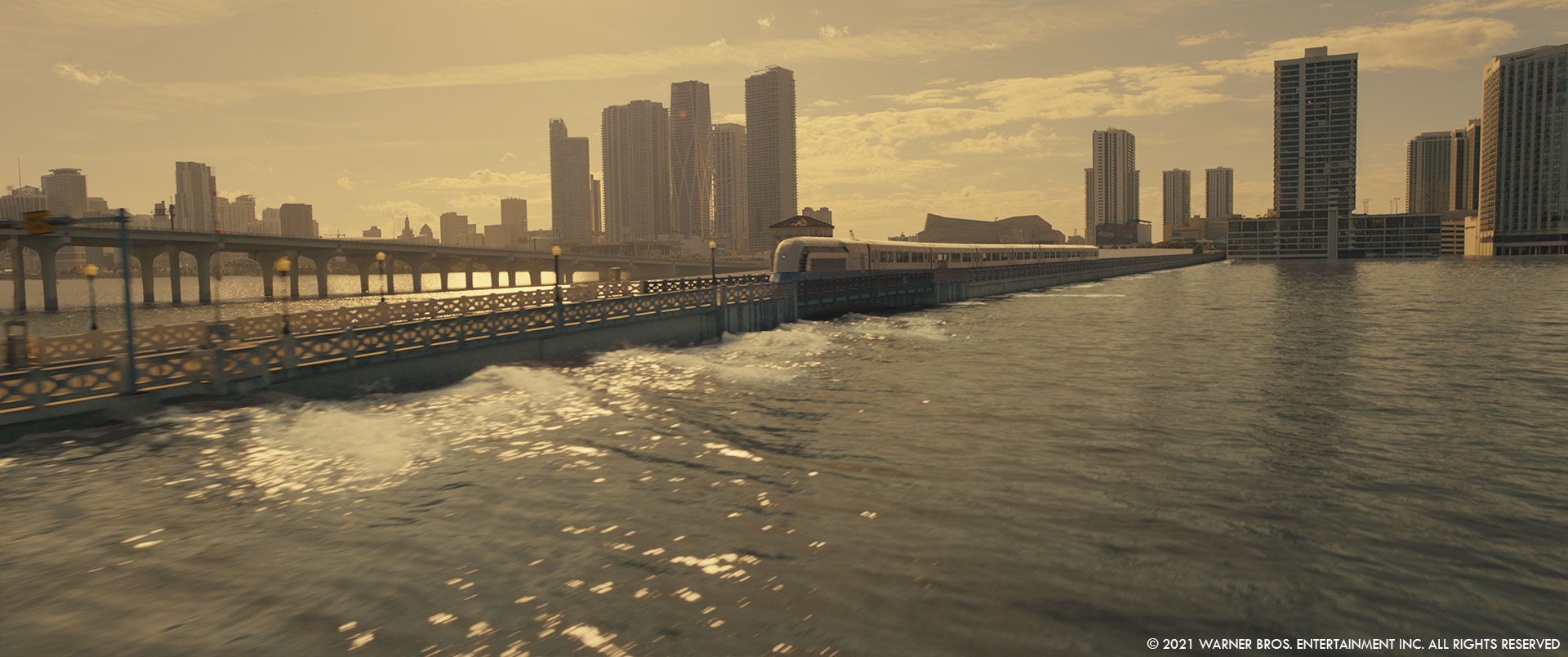
How did you handle the underwater shots especially with Hugh Jackman?
Hugh Jackman’s character Bannister is diving after the villain who gets stuck in a piano, dragging him into a sunken auditorium. Production really shot this sequence in a tank in front of black, built the first rows of the auditorium and put a grand piano in. Hugh Jackman is the guy in front of the camera in every single shot. But we enhanced the environment with a crumbling stage, torn curtains that blow in the current, plankton particulate, fish and plants and plenty of additional rows of seats. The asset of the auditorium was loosely based on an auditorium from a abandoned school in the US. We added collapsed balconies and things that would make sense underwater. To get some color back, overgrown parts of the walls, seats and balconies add a hint of purple and orange so that the sequence doesn’t play completely monochromatic. On top of the set extension work, FX added rising bubbles from cracks in the wooden floor and from our talent fighting in the tank.
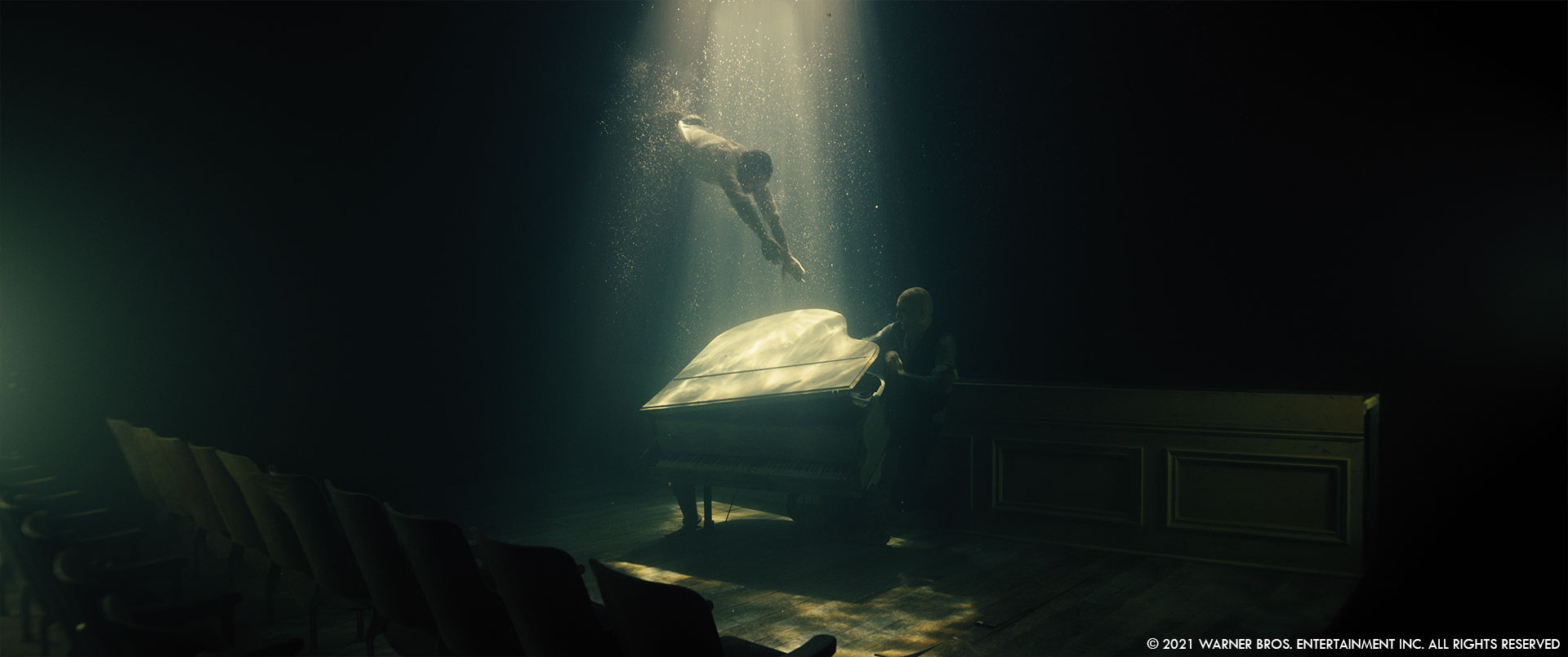
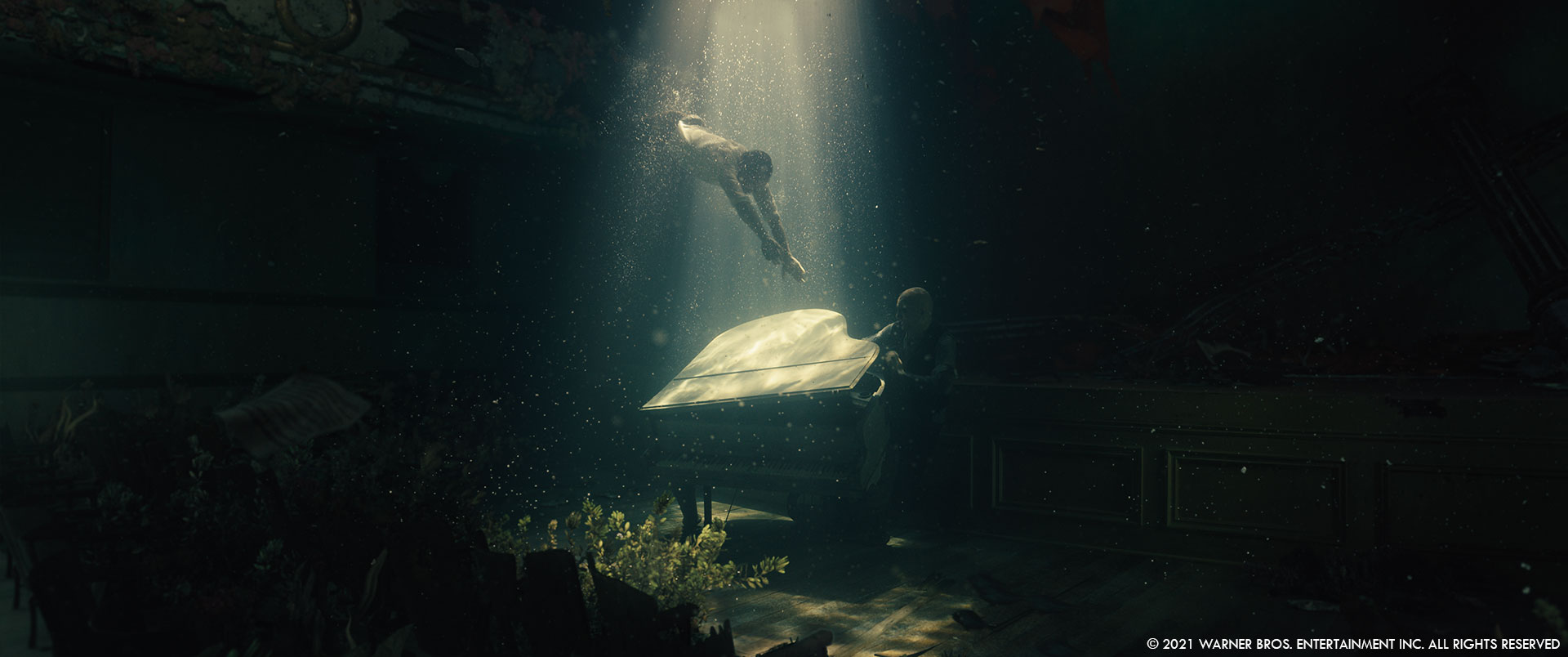
Which shot or sequence was the most challenging?
The Opening. Shot.
Is there something specific that gives you some really short nights?
The Opening. Shot.
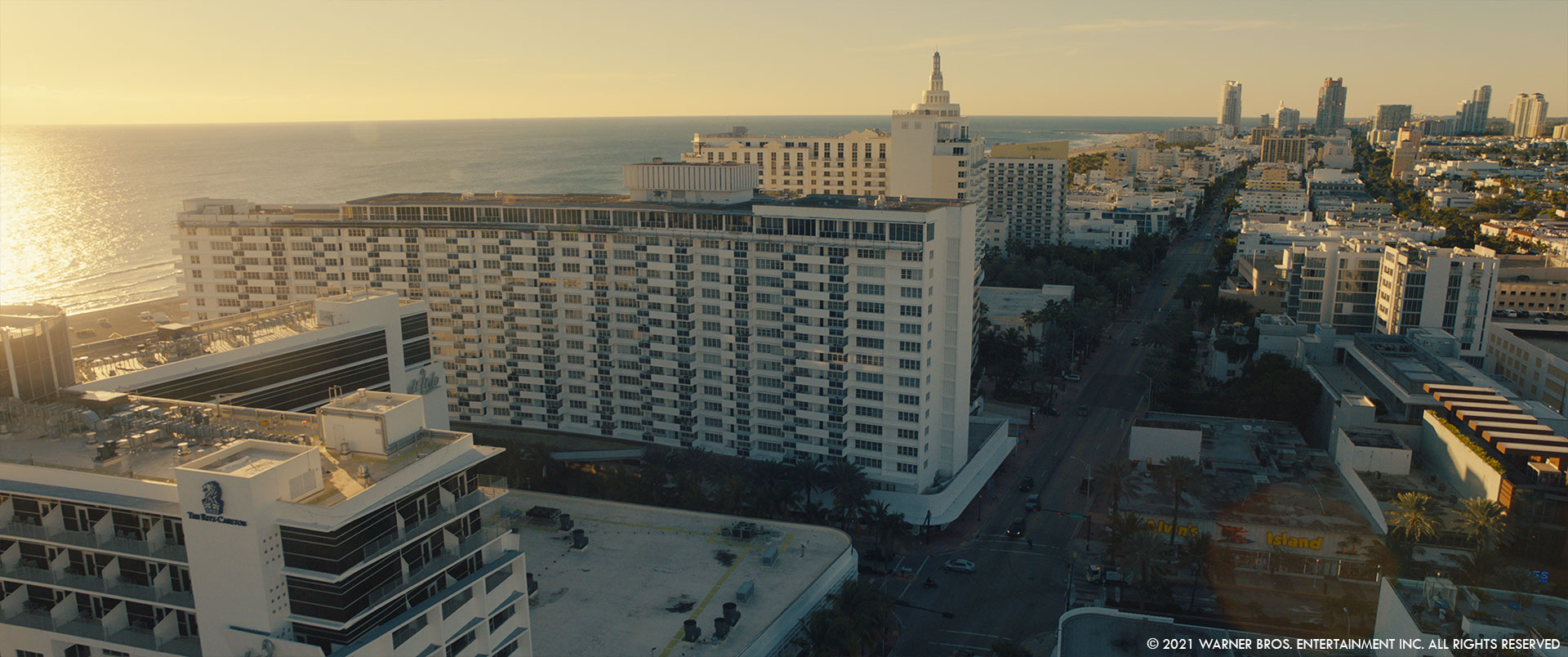
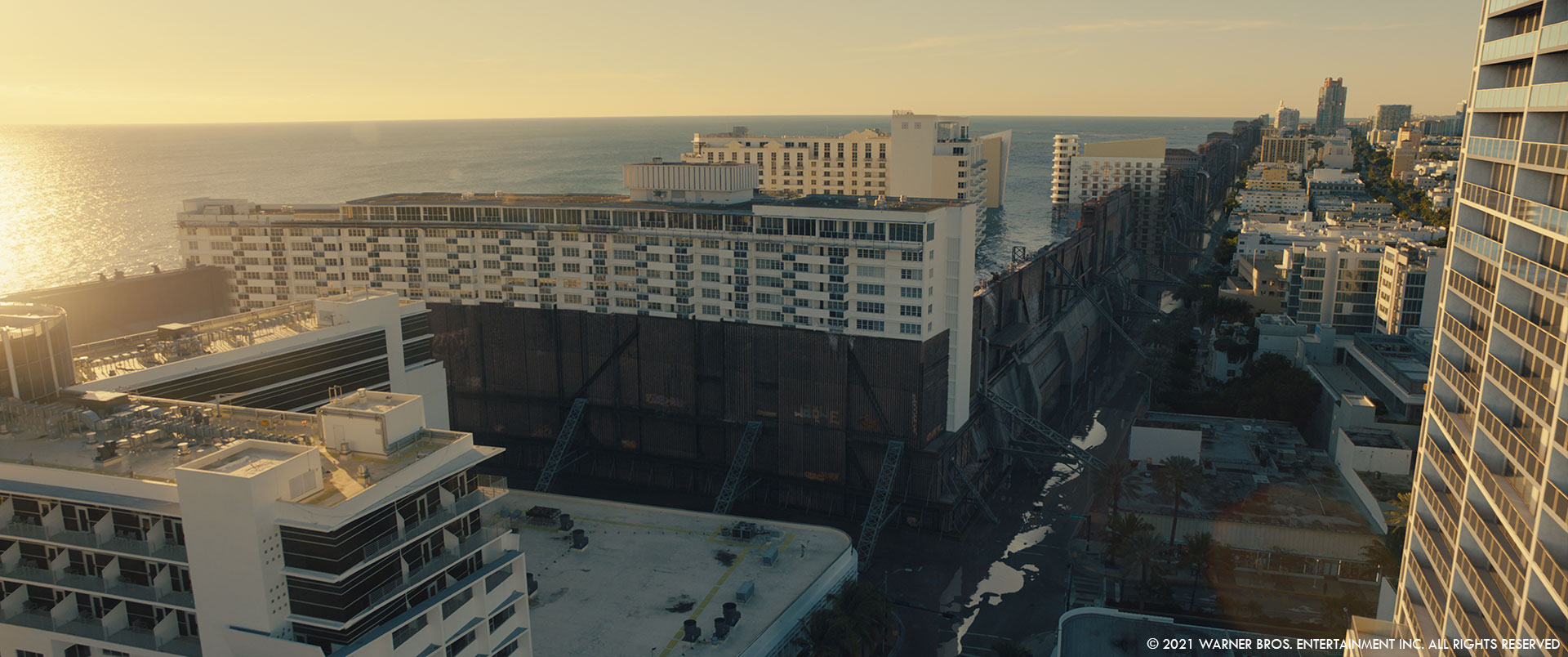
What is your favorite shot or sequence?
I would have to say the… opening shot 😉
What is your best memory on this show?
Looking back, working with a team remotely was a terrible experience. You don’t know what everyone is doing because you can’t glance at their screens. But the team changed the way they communicated and outdid themselves with the amount of output they produced. I think everyone is incredibly proud of what we created, despite the extra mile we had to go.
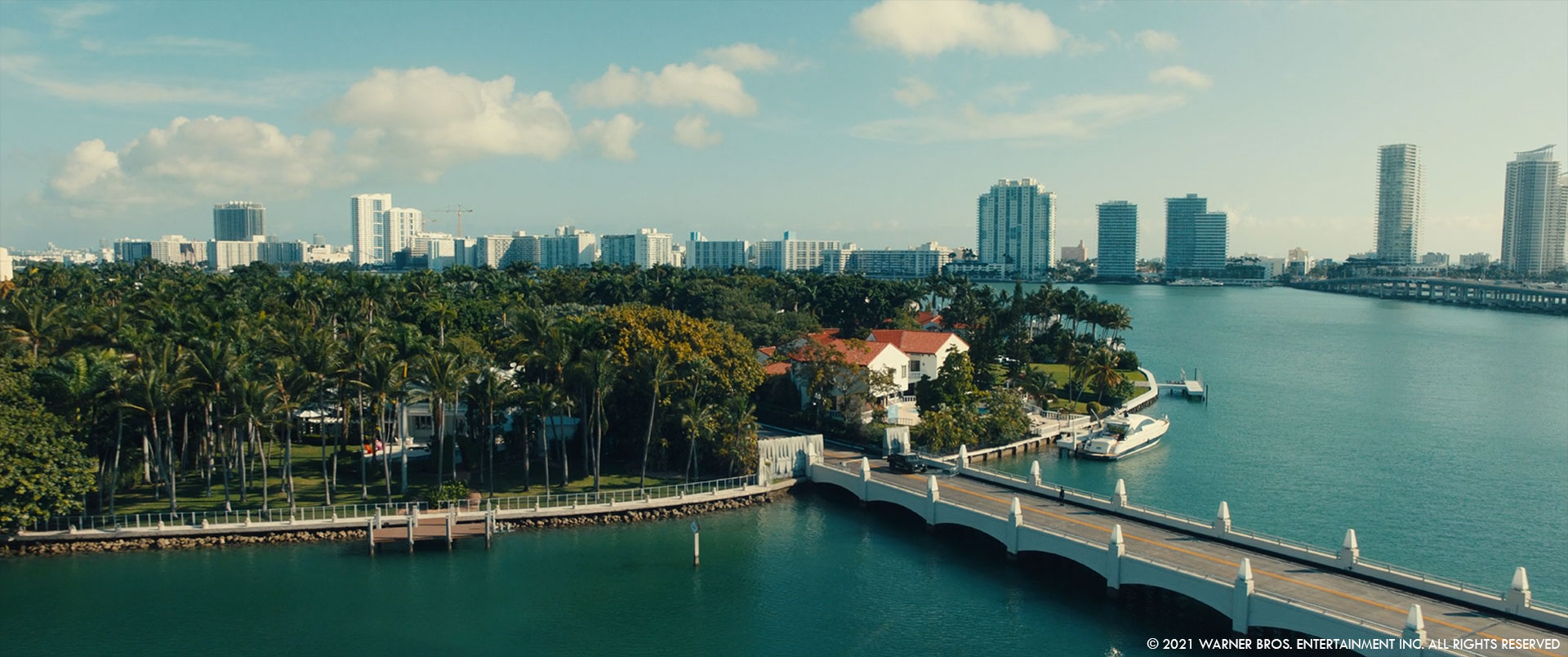
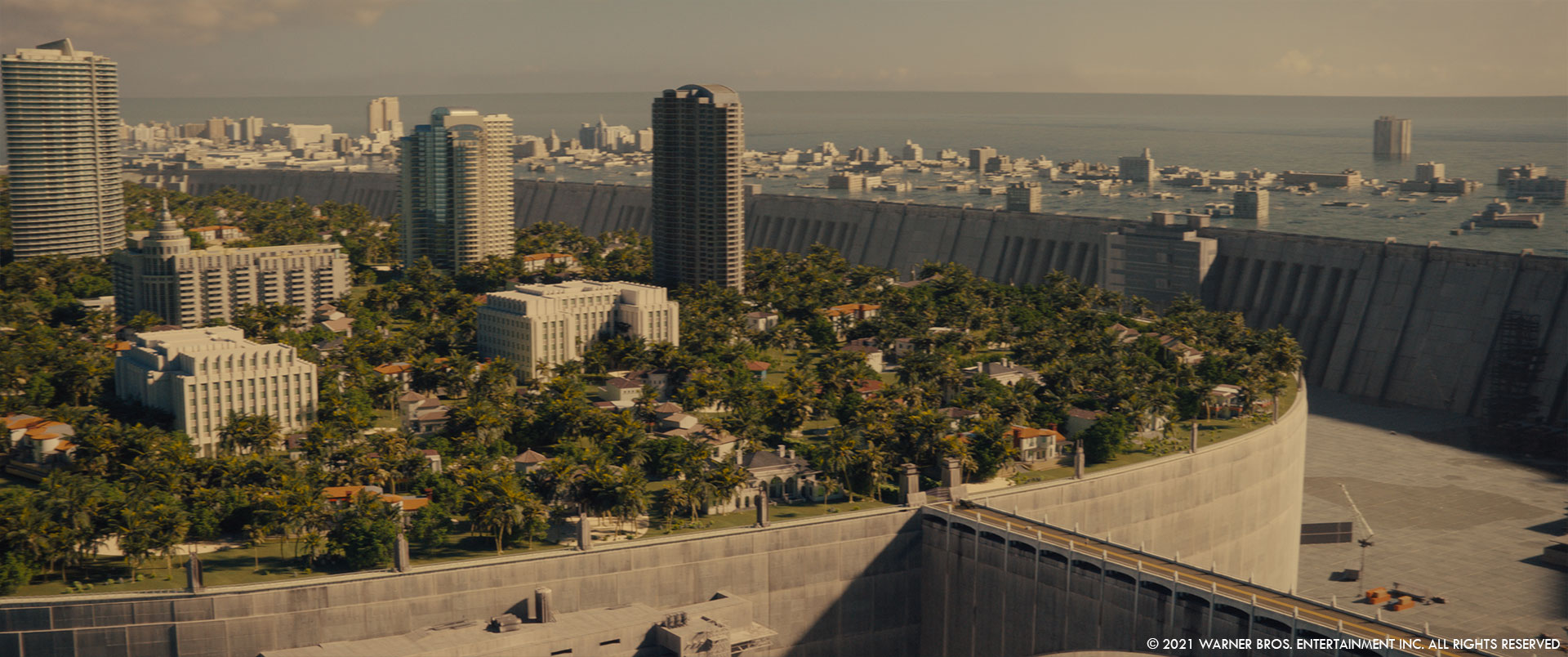
How long have you worked on this show?
Roughly 8 months.
What’s the VFX shots count?
Just 120 nerve-wreckingly complicated and long shots.
What was the size of your team?
About 120 artists – one per shot you could think. But that was obviously not the case.
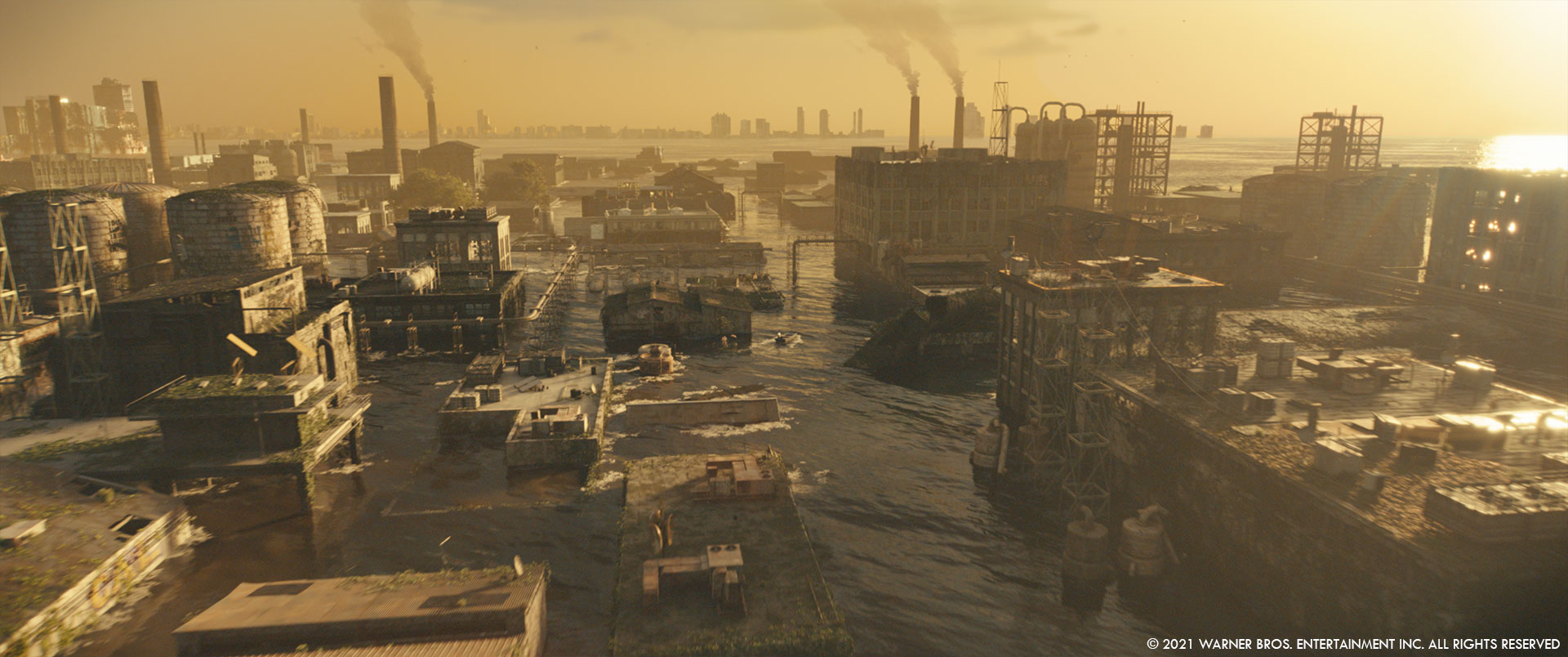
What is your next project?
I don’t have a particular show of my own at the moment because (most of the time) I’m only executive producing all work across all offices at RISE. Right now I’m overlooking exciting paperwork for 6-7 shows.
A big thanks for your time.
WANT TO KNOW MORE?
RISE: Dedicated page about Reminiscence on RISE website.
Bruce Jones: My interview of Overall VFX Supervisor Bruce Jones about Reminiscence.
HBO Max: You can watch Reminiscence on HBO Max.
© Vincent Frei – The Art of VFX – 2021




